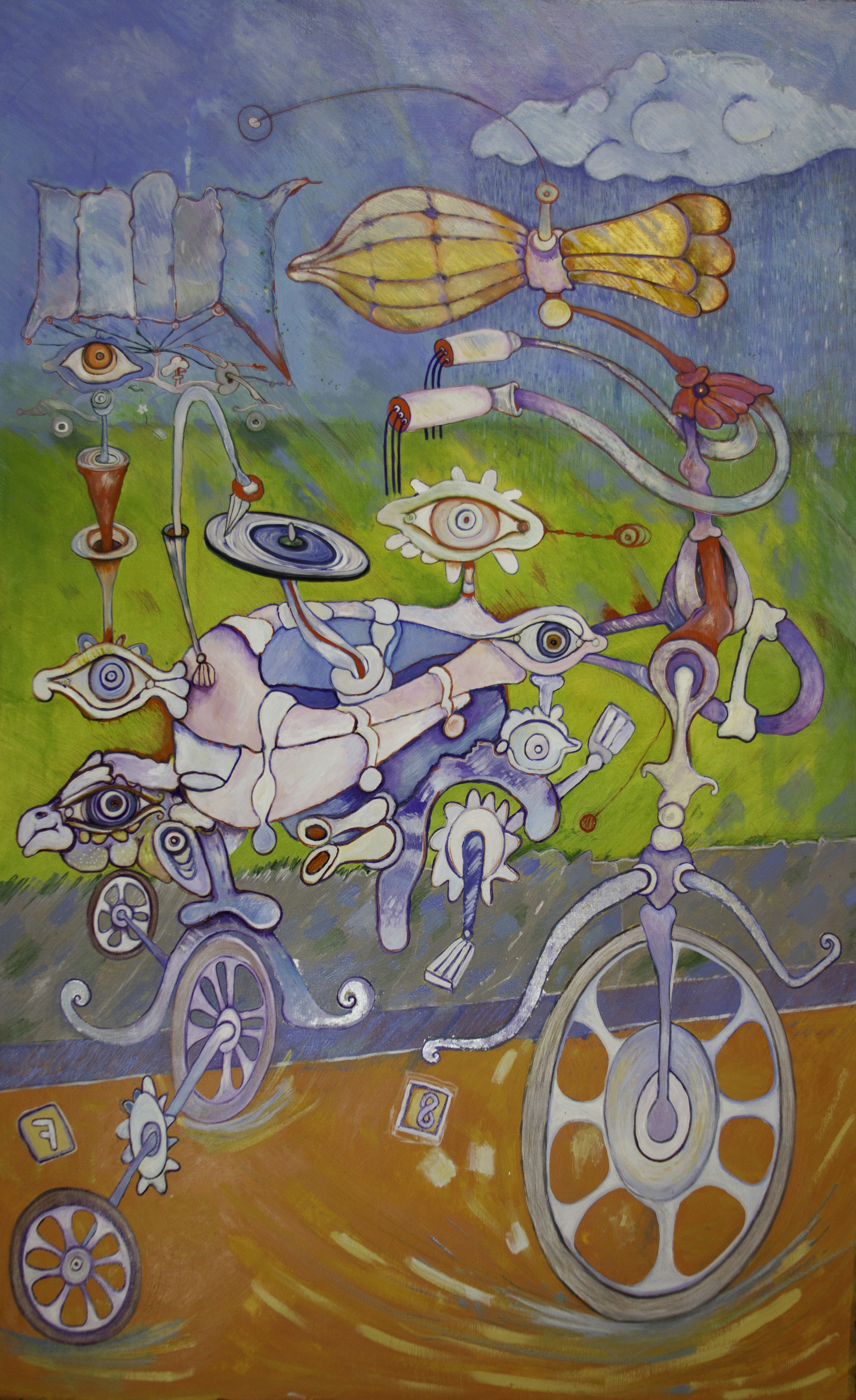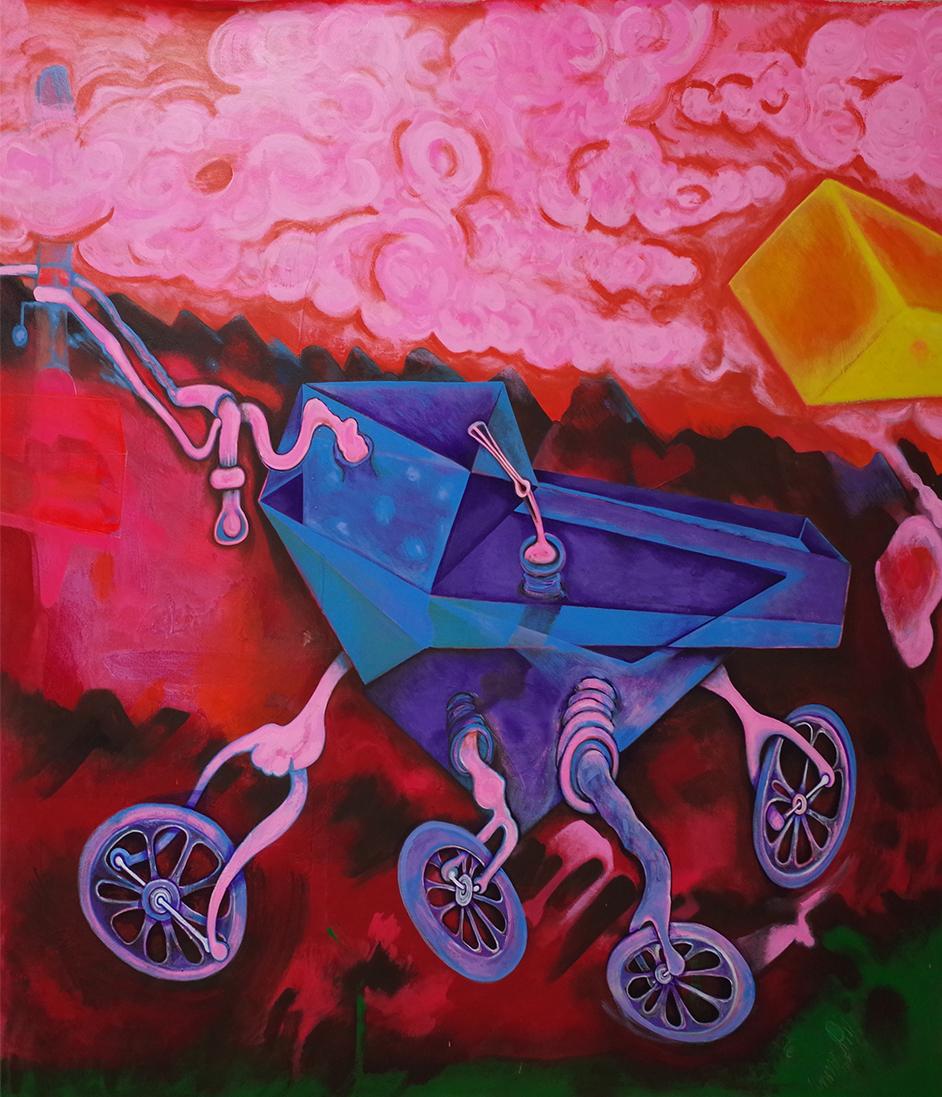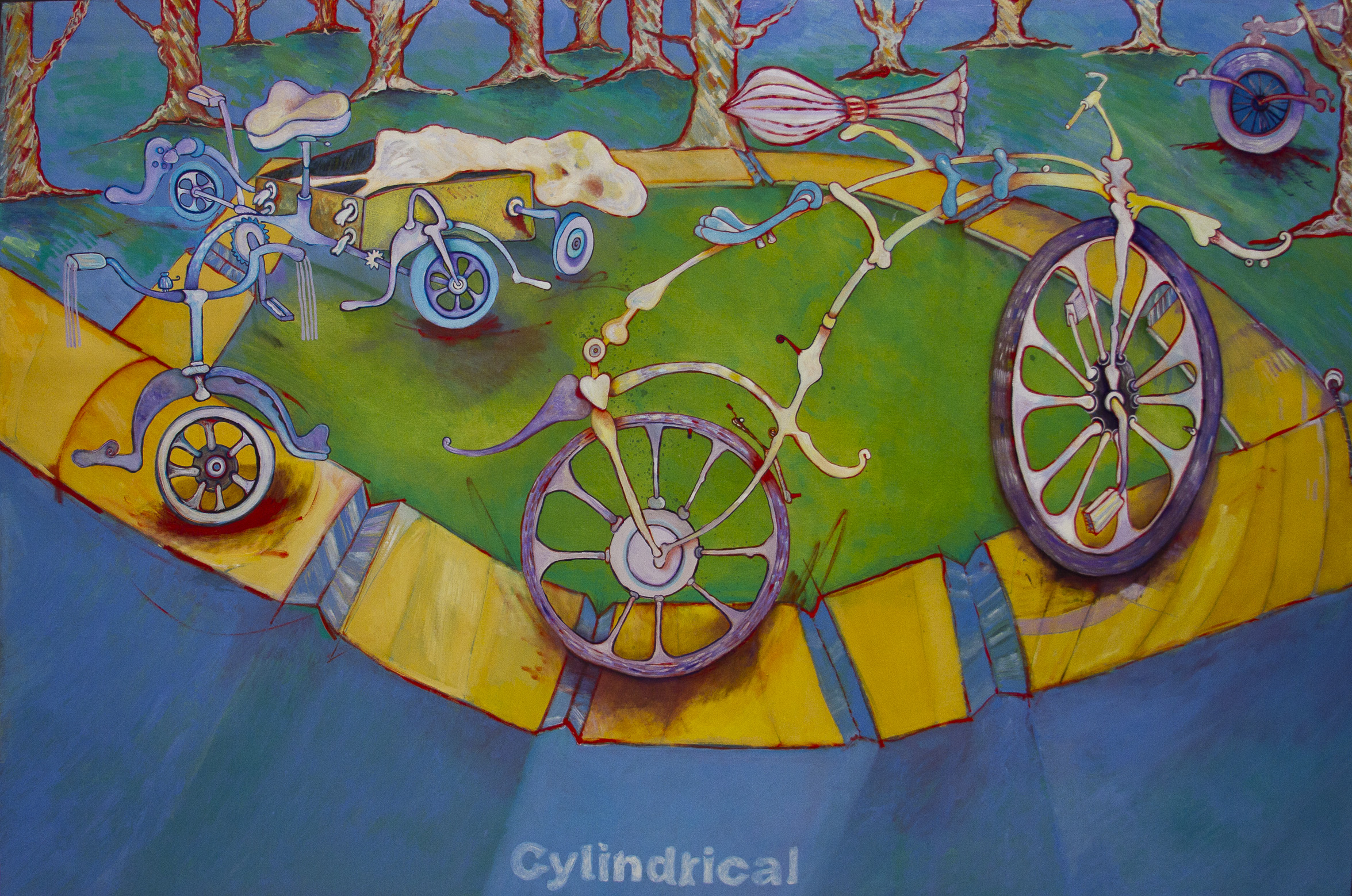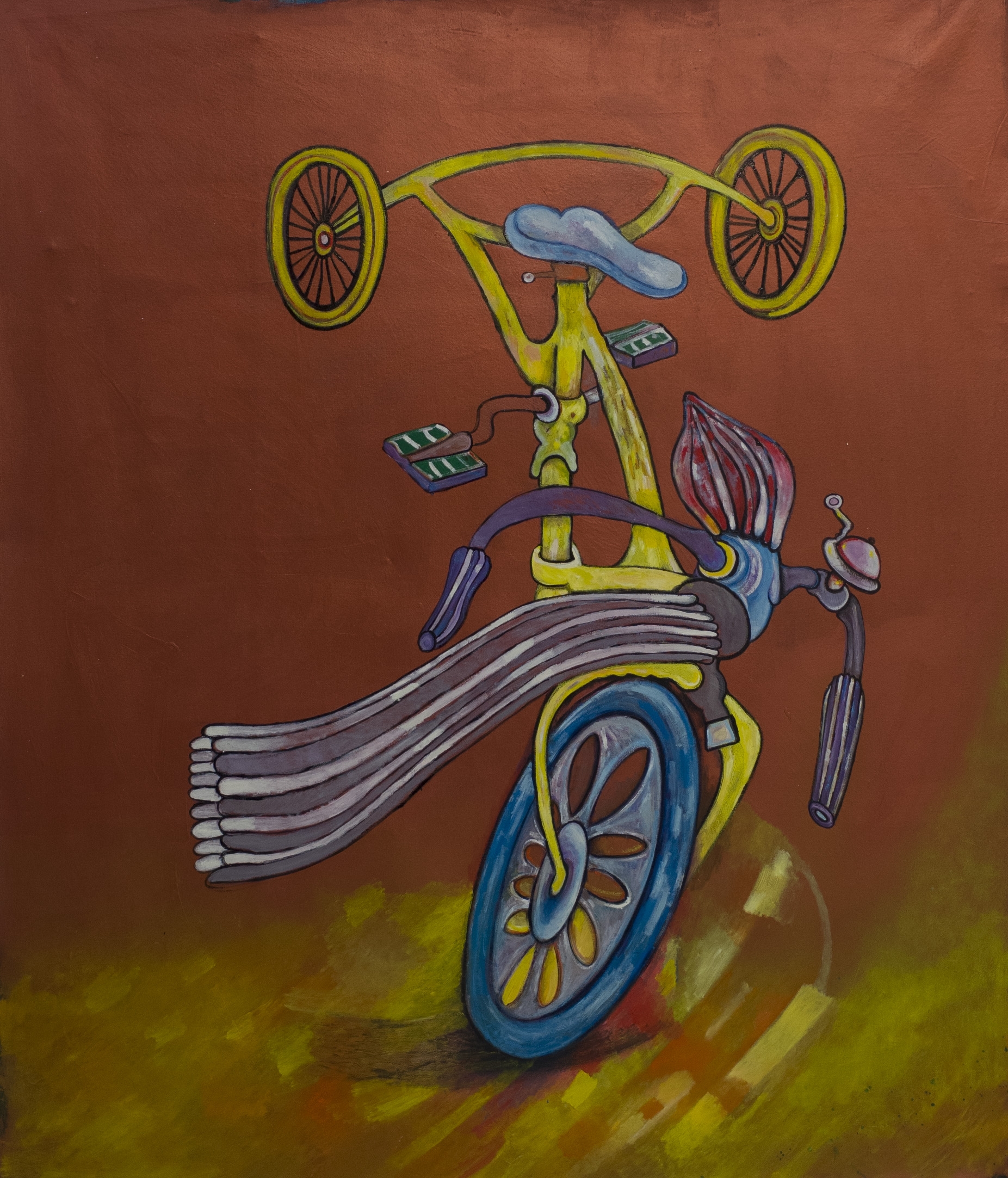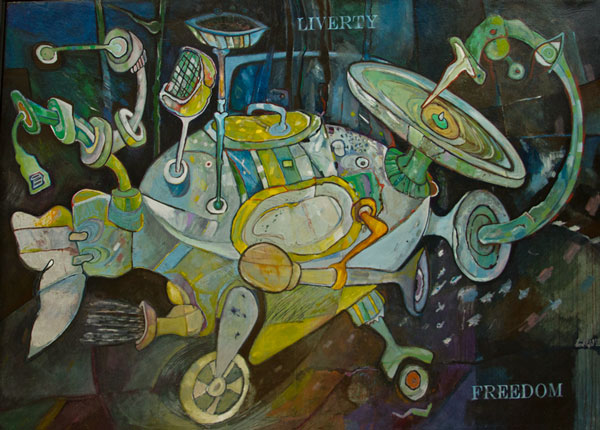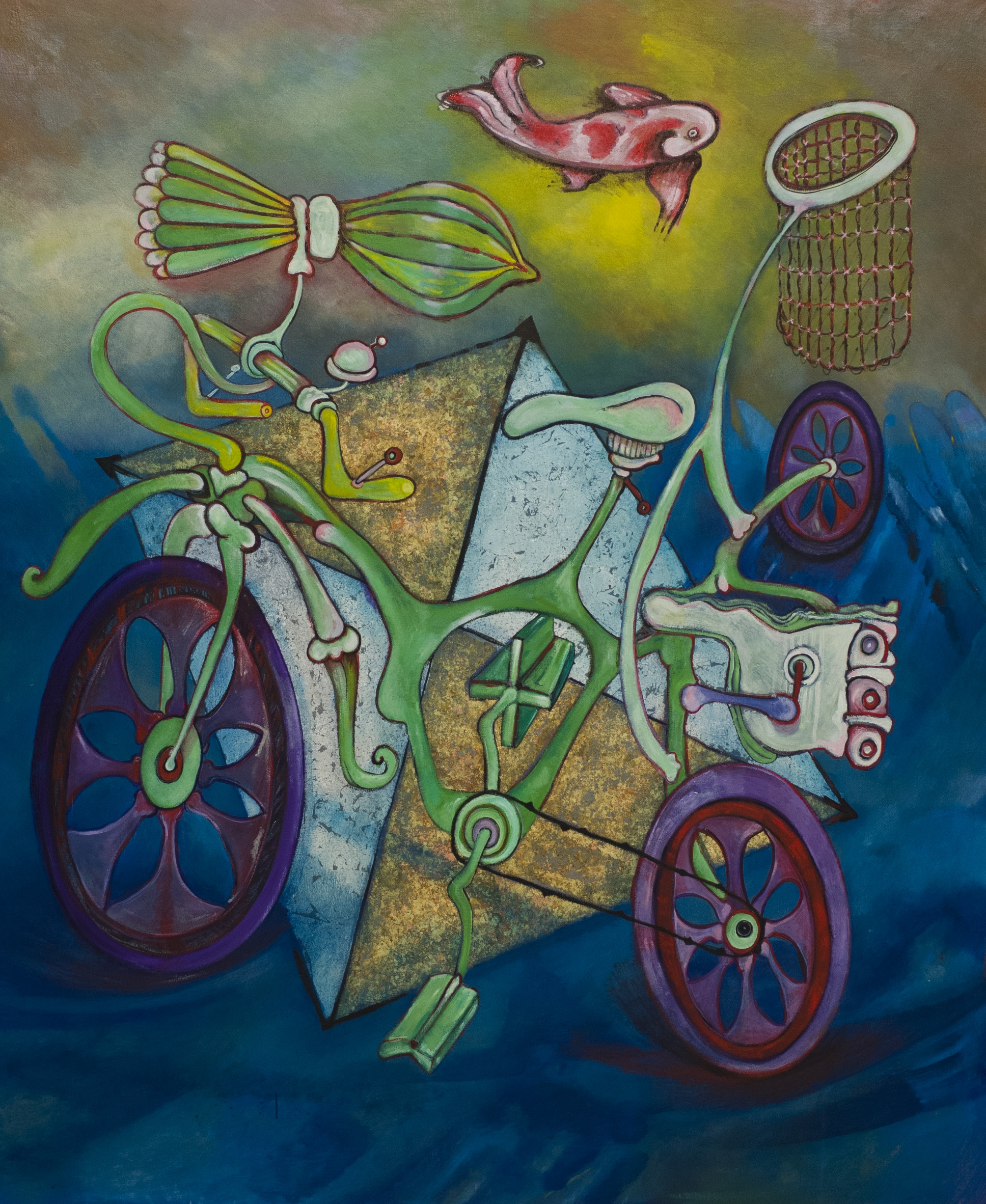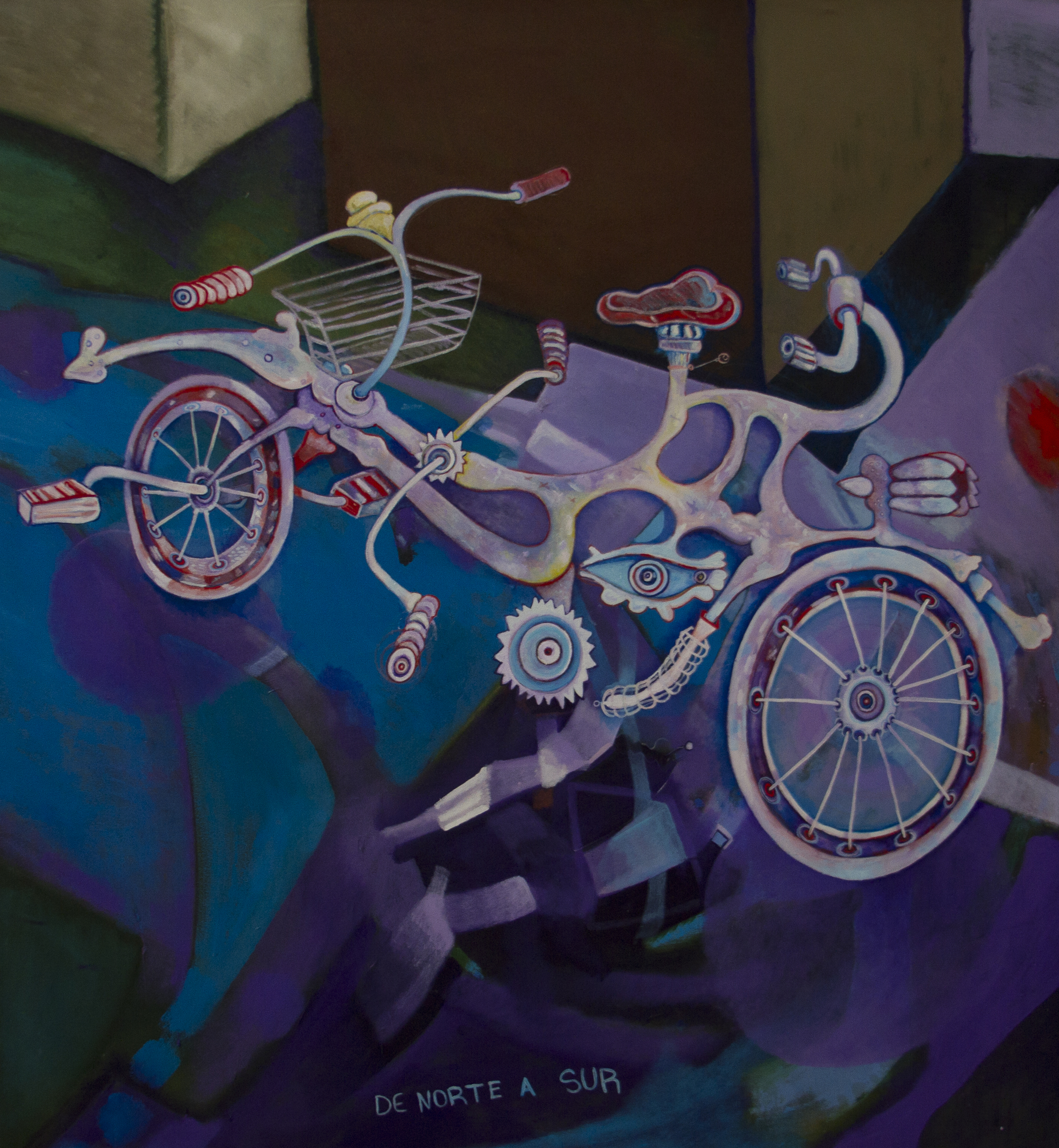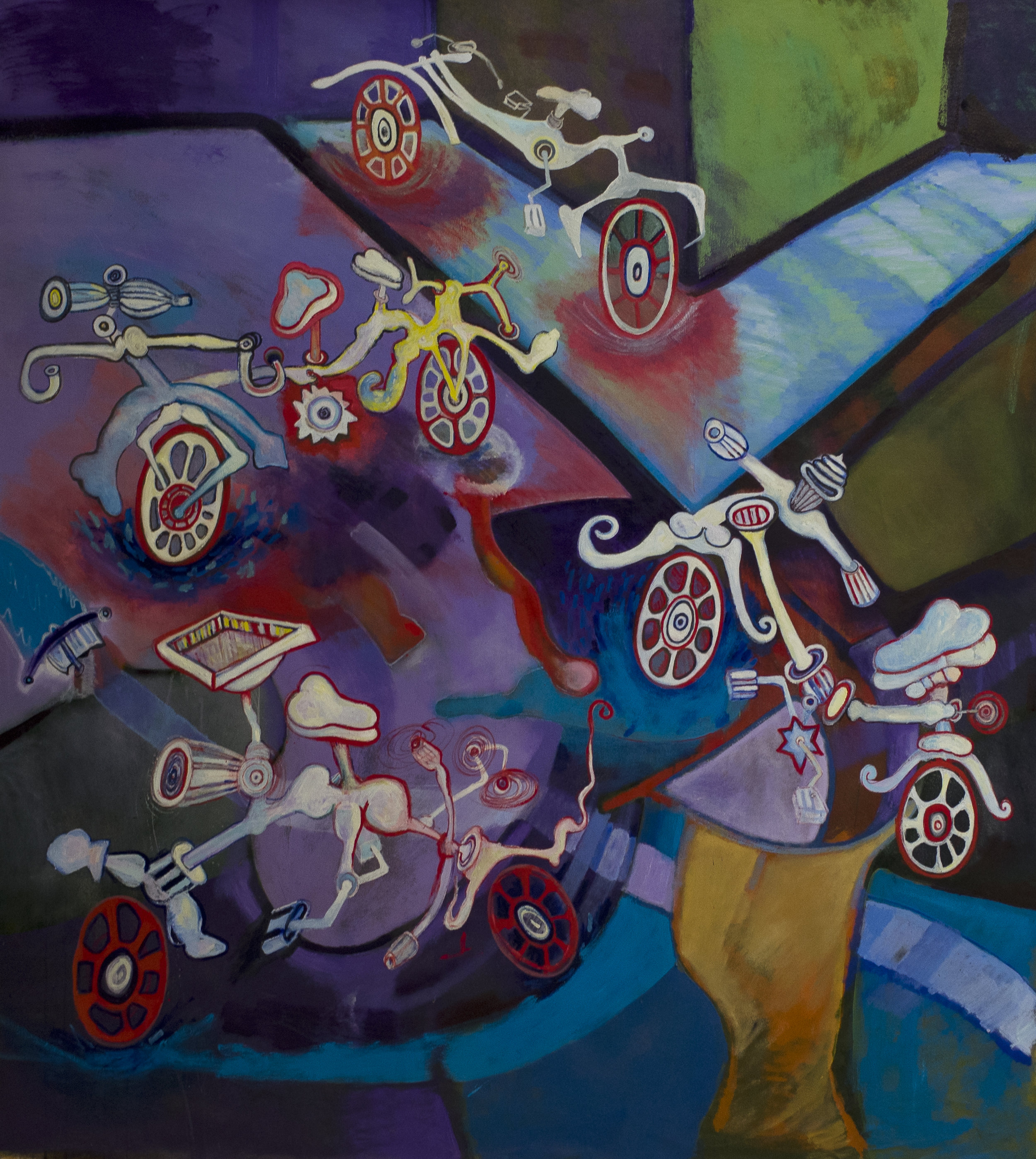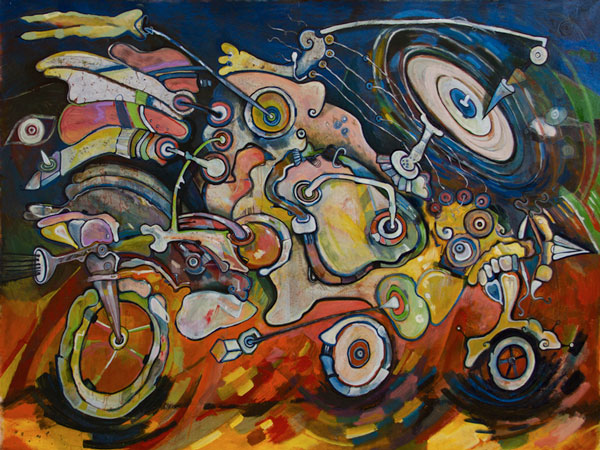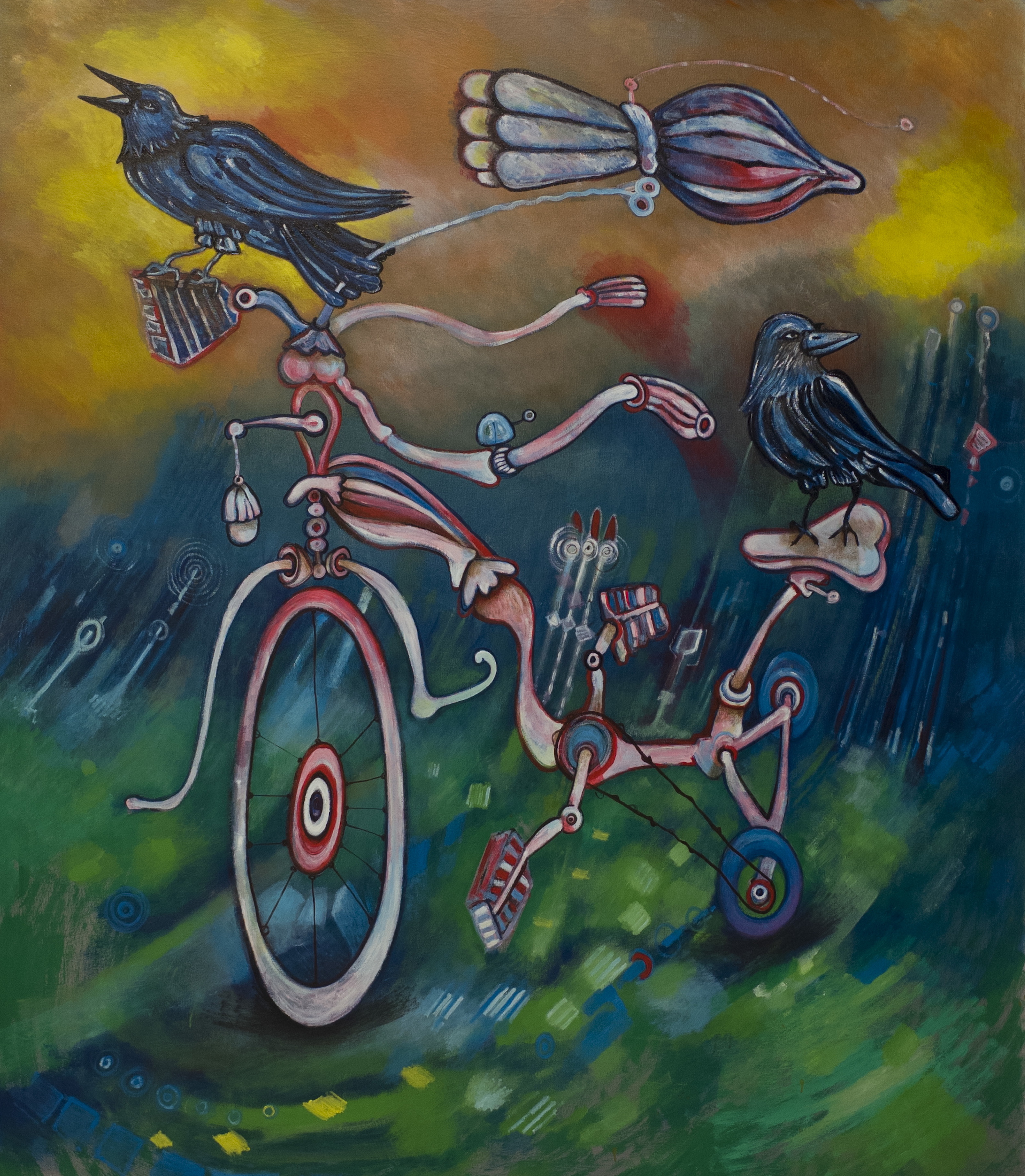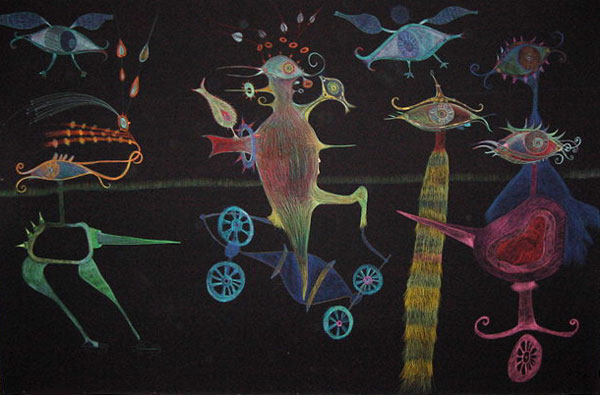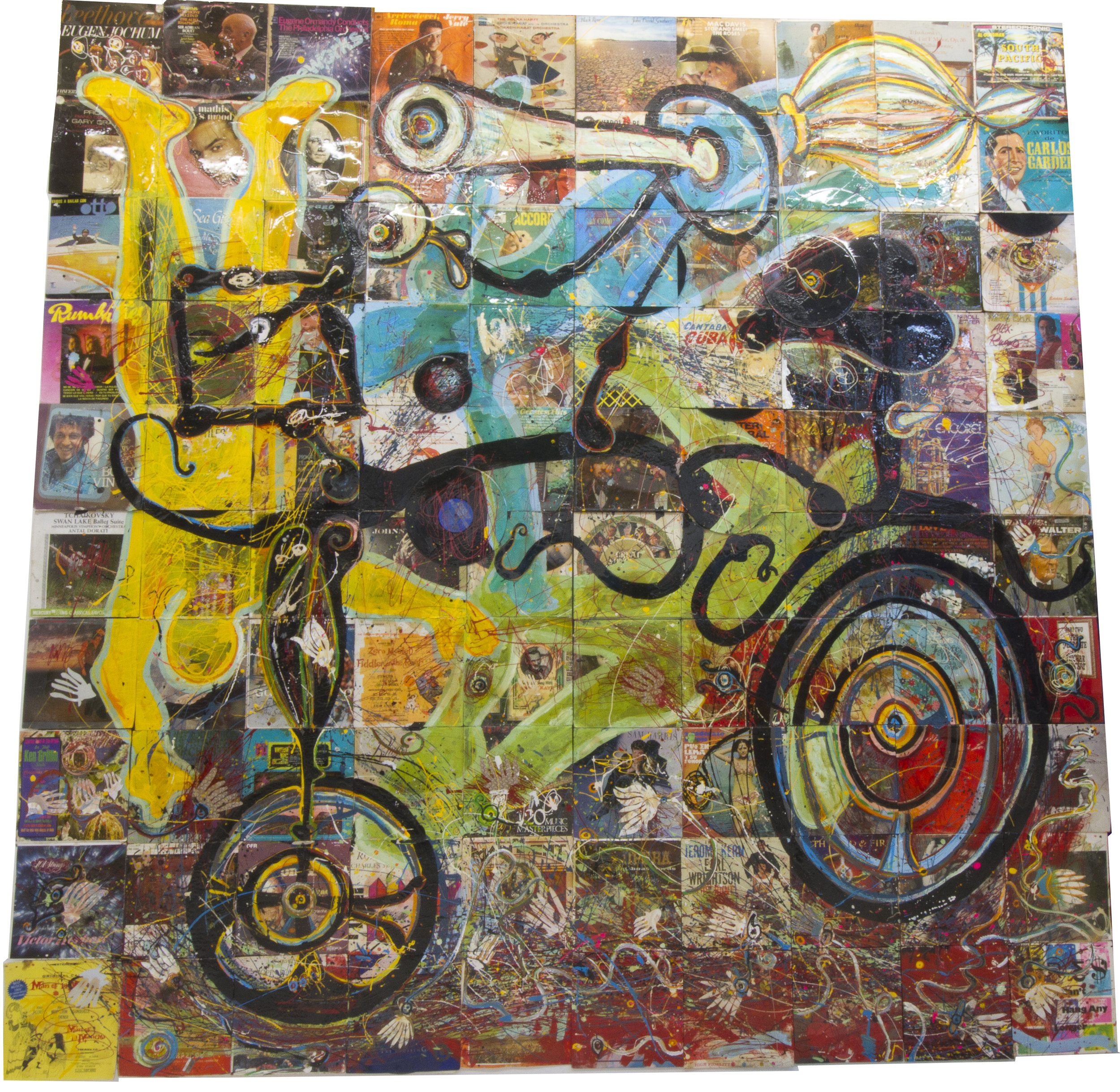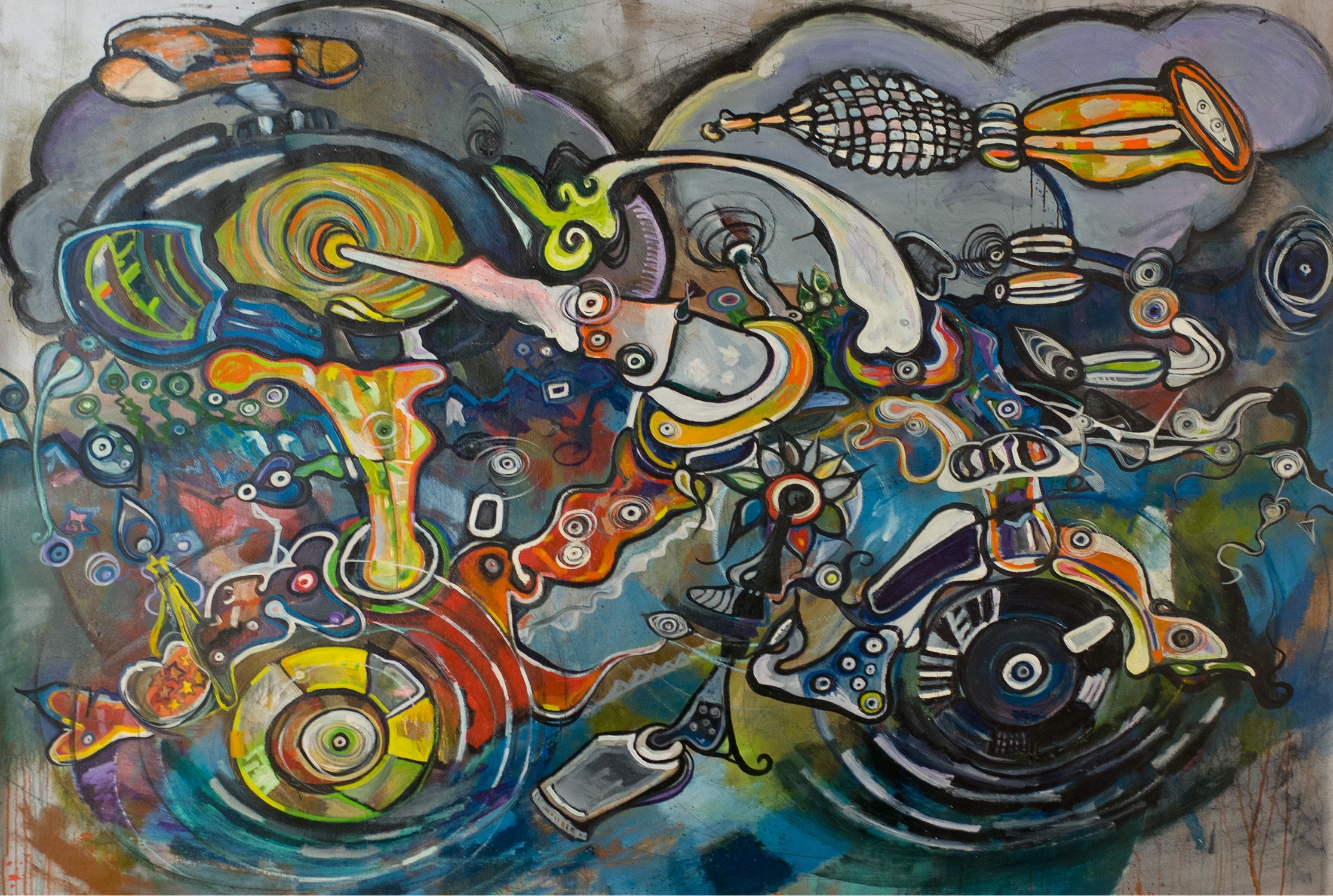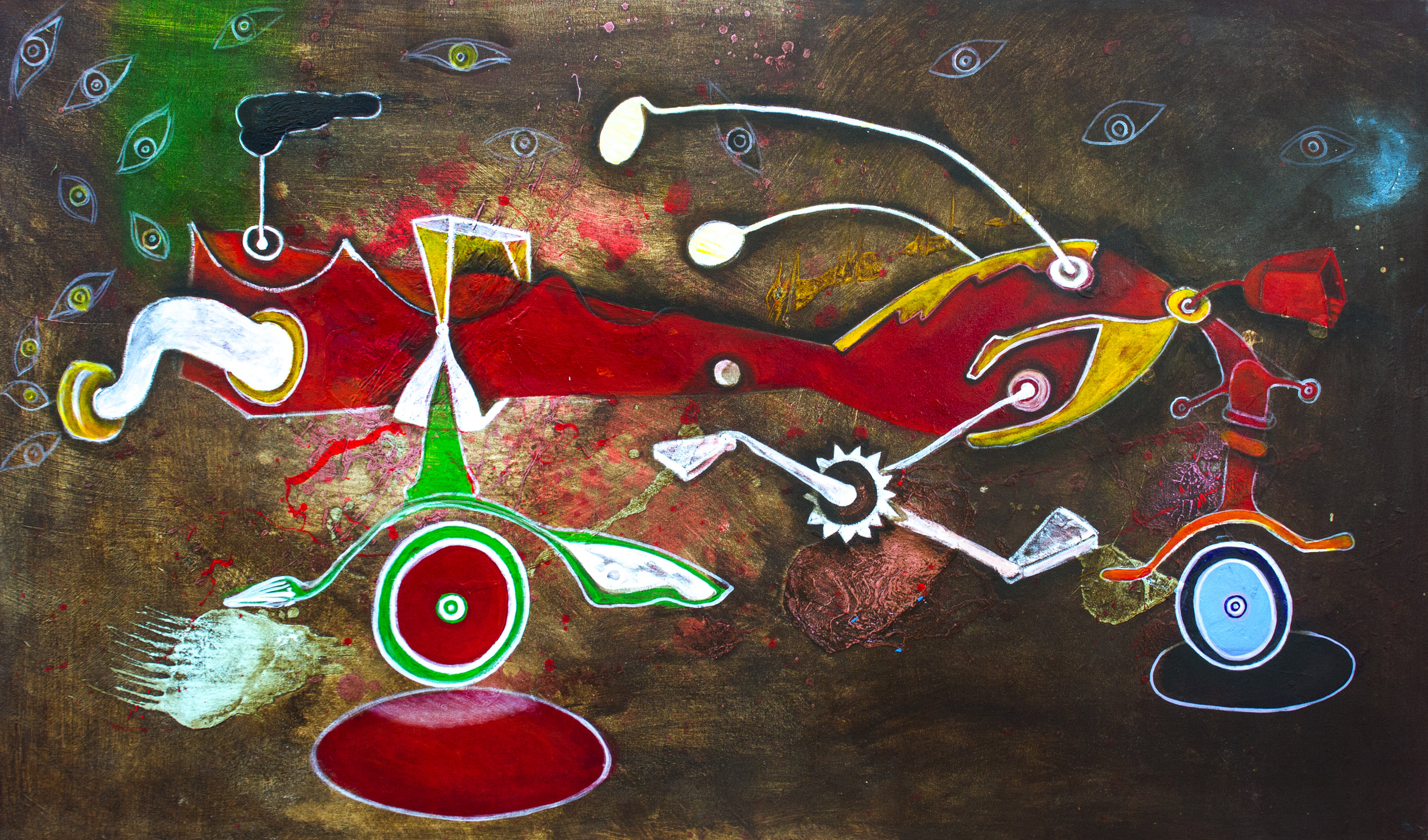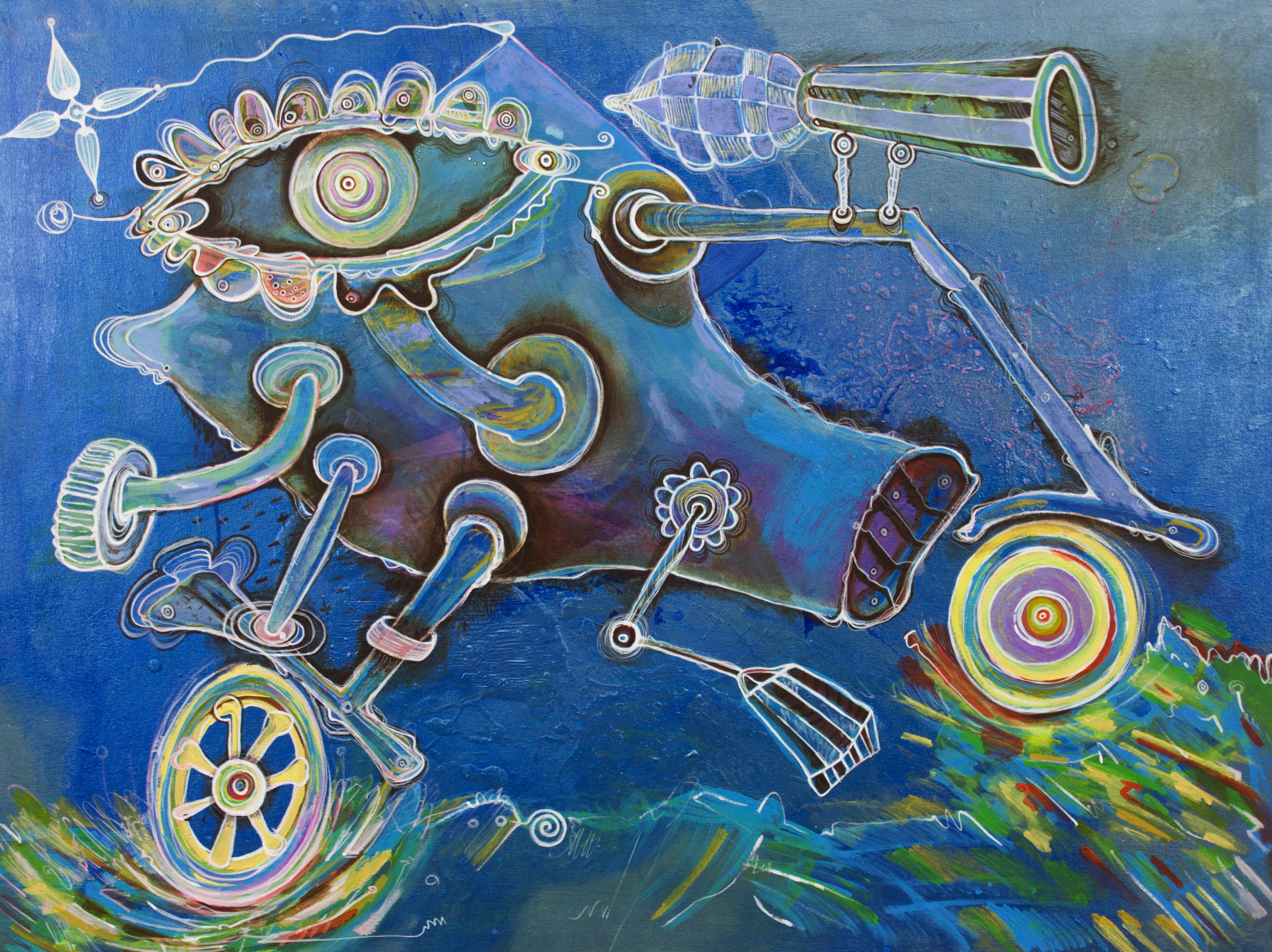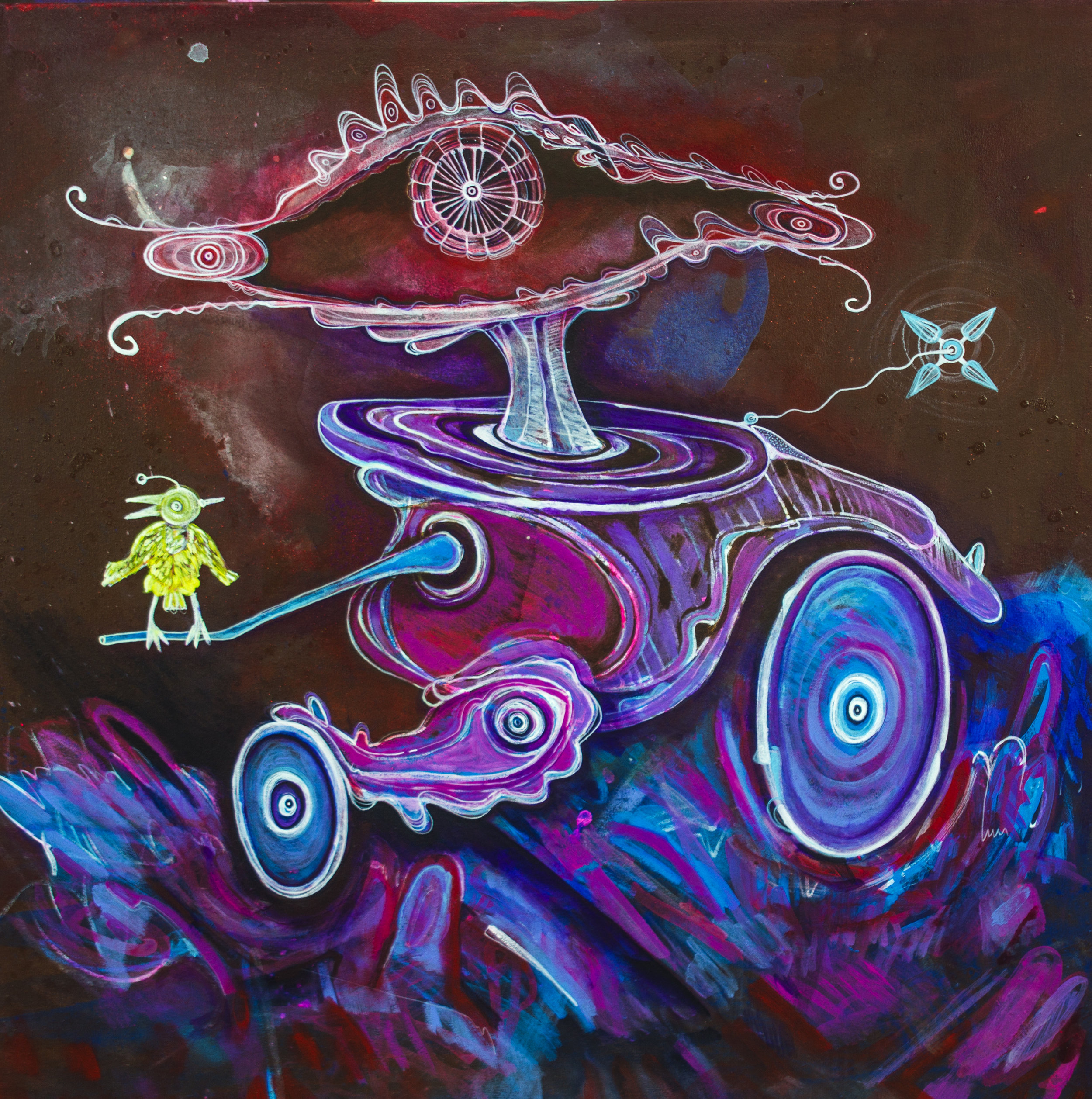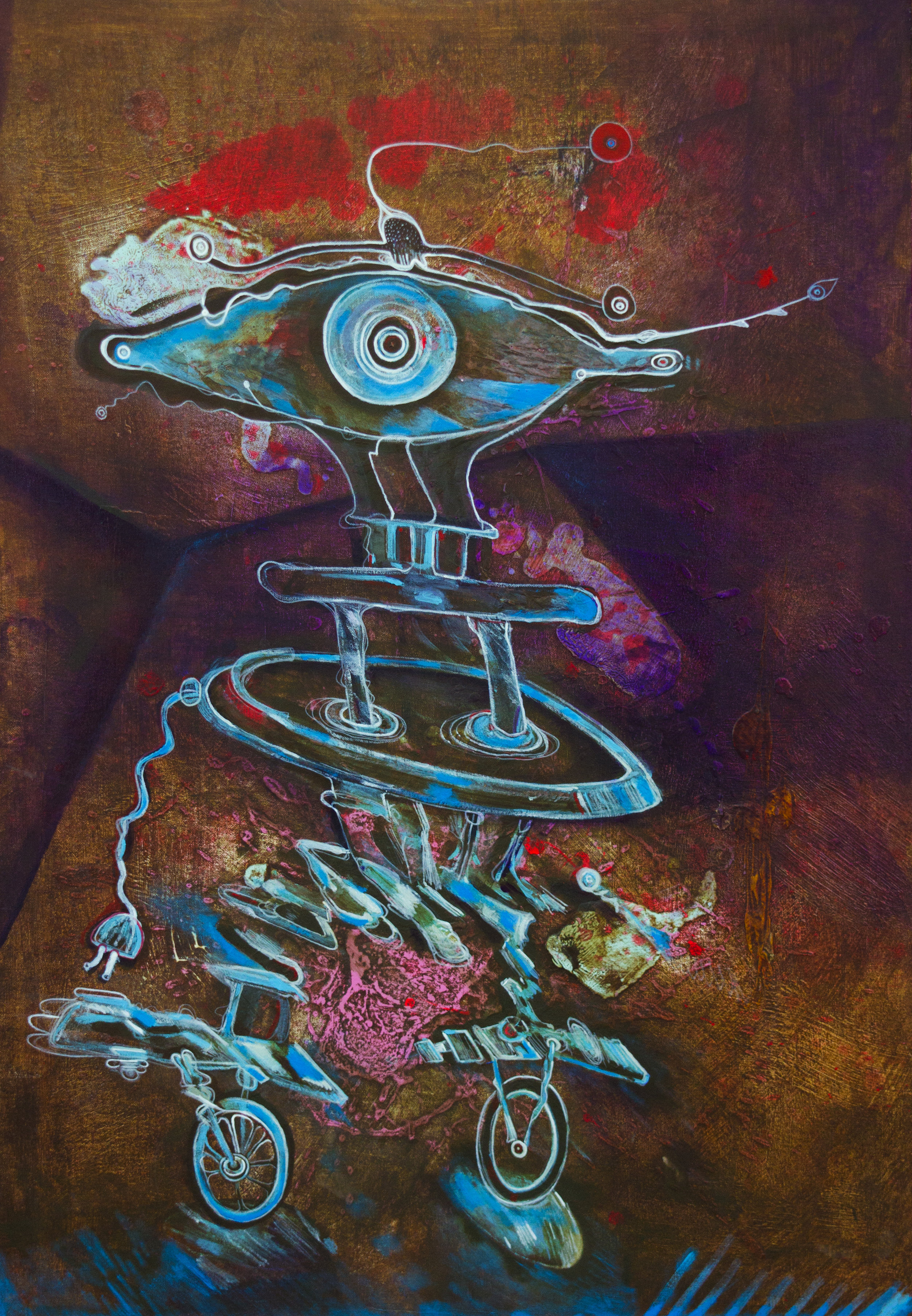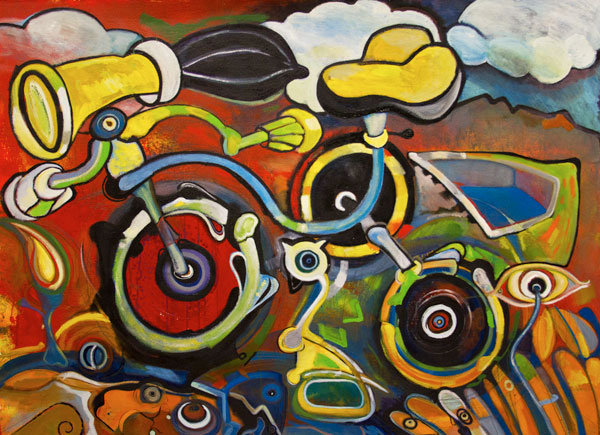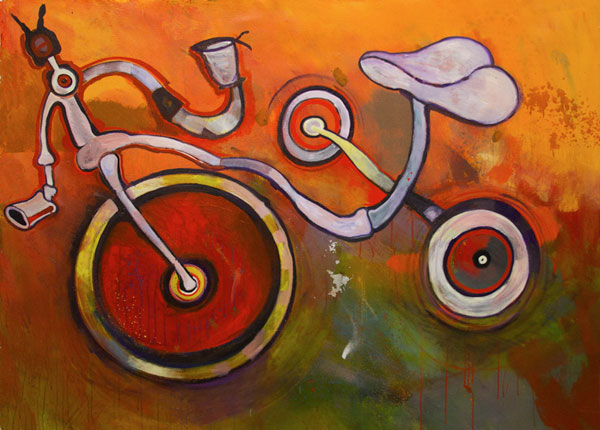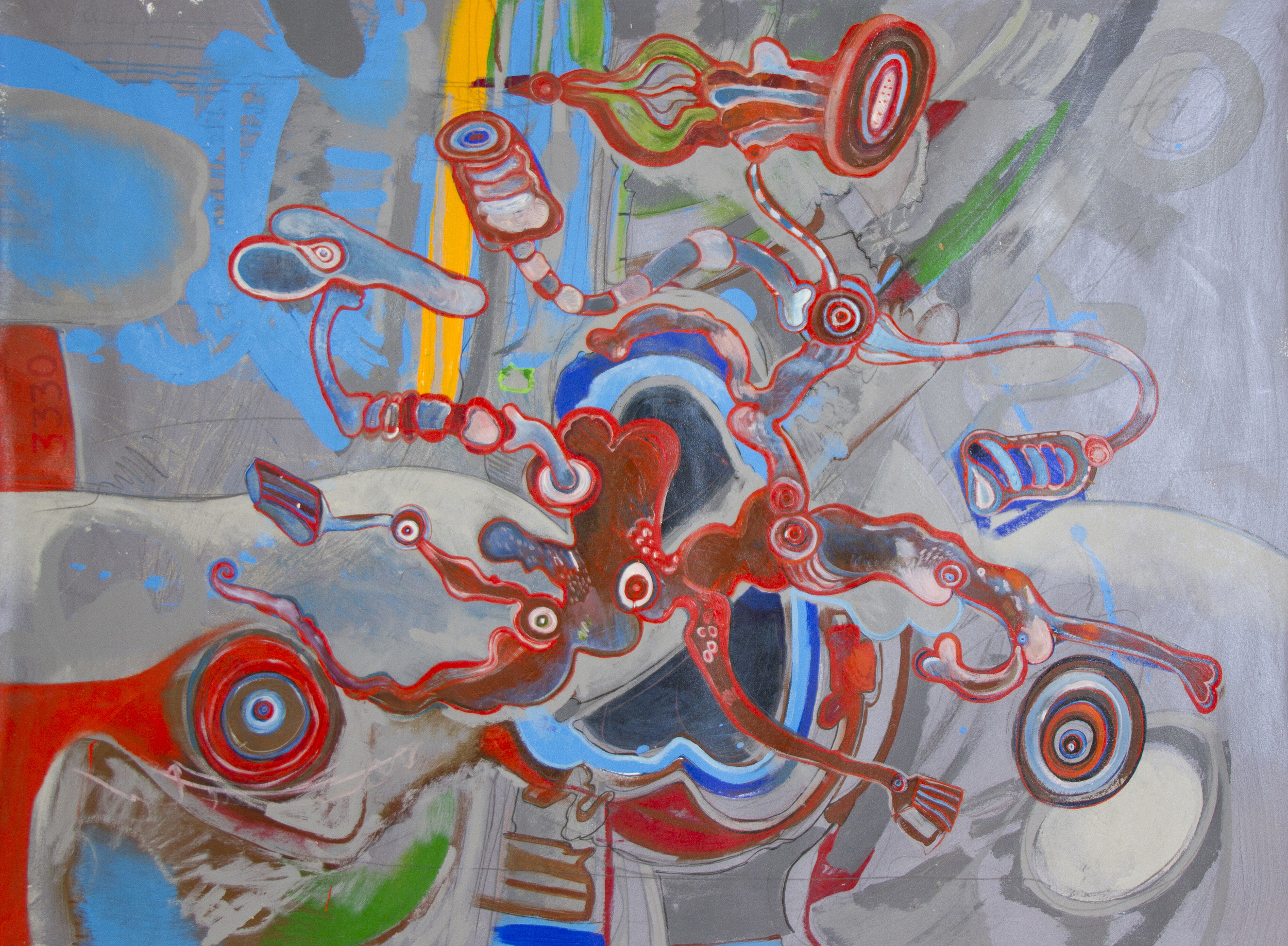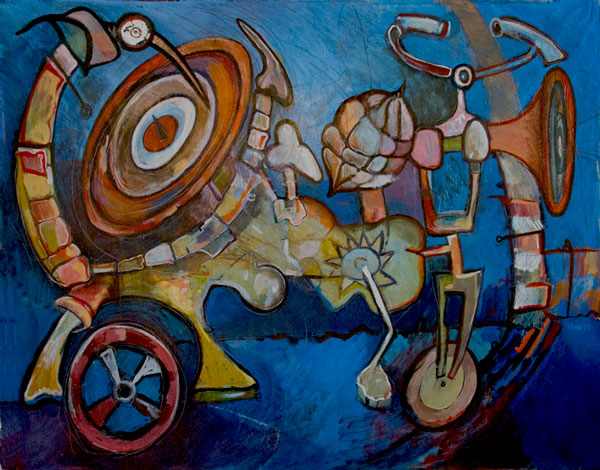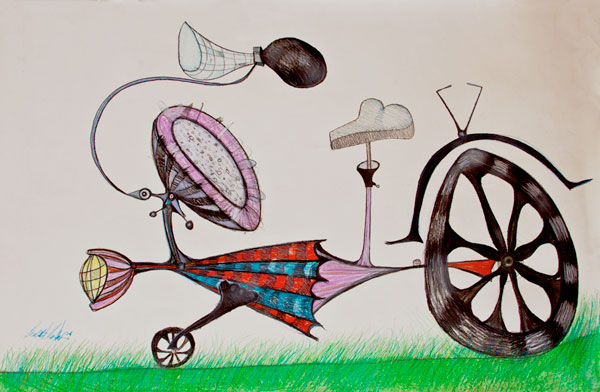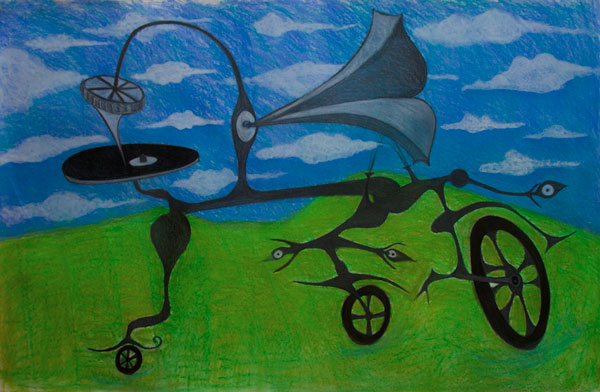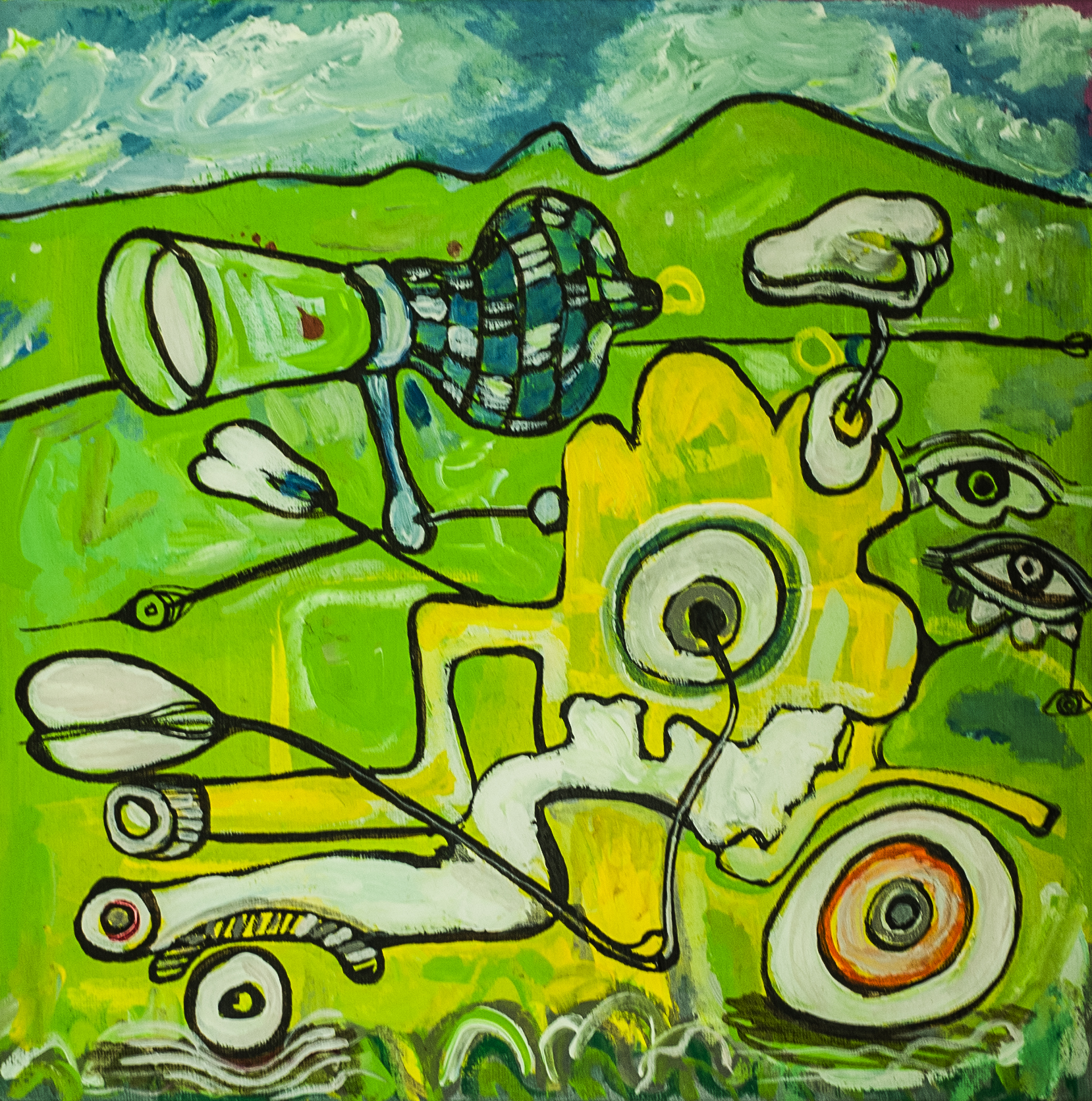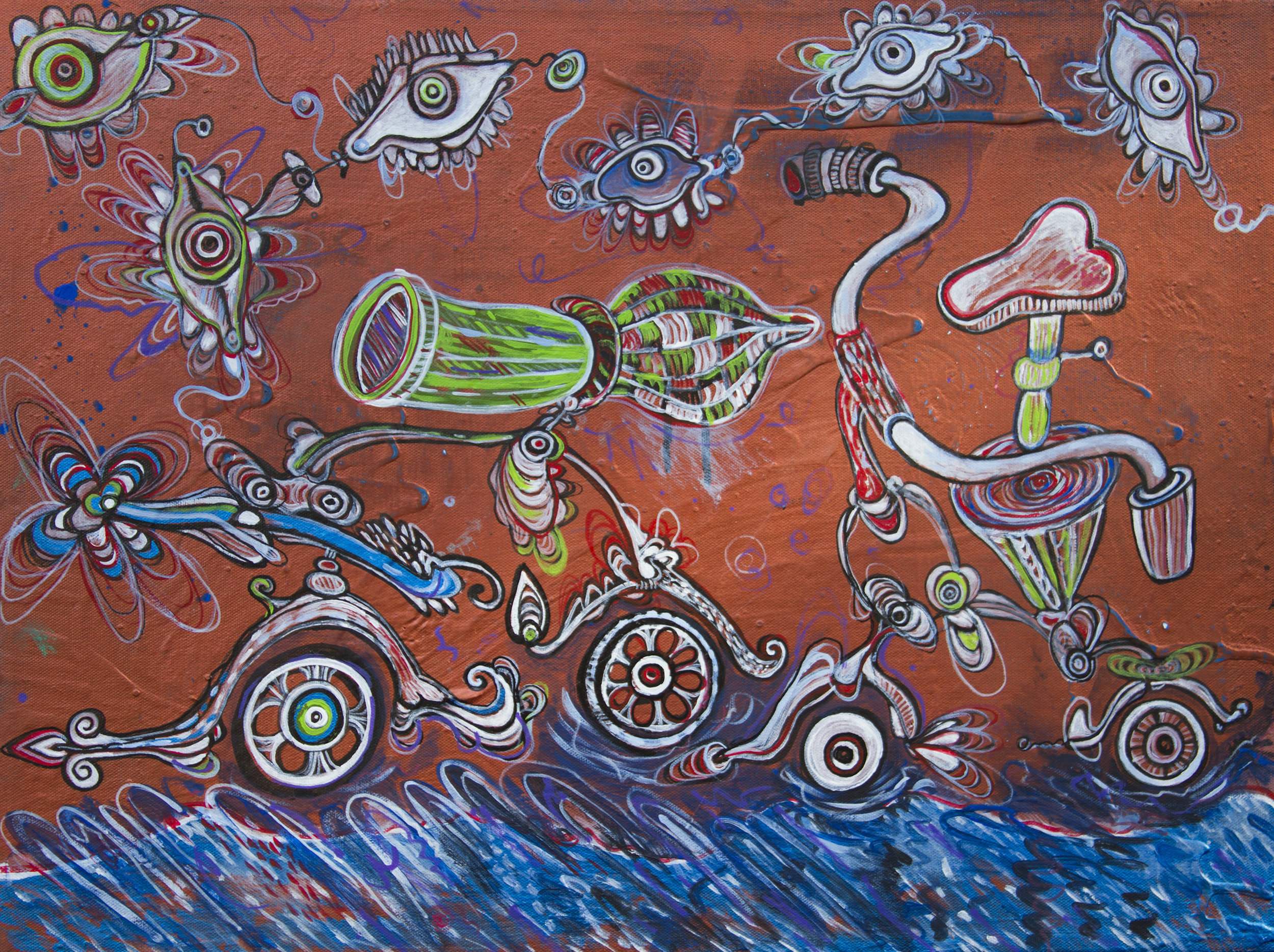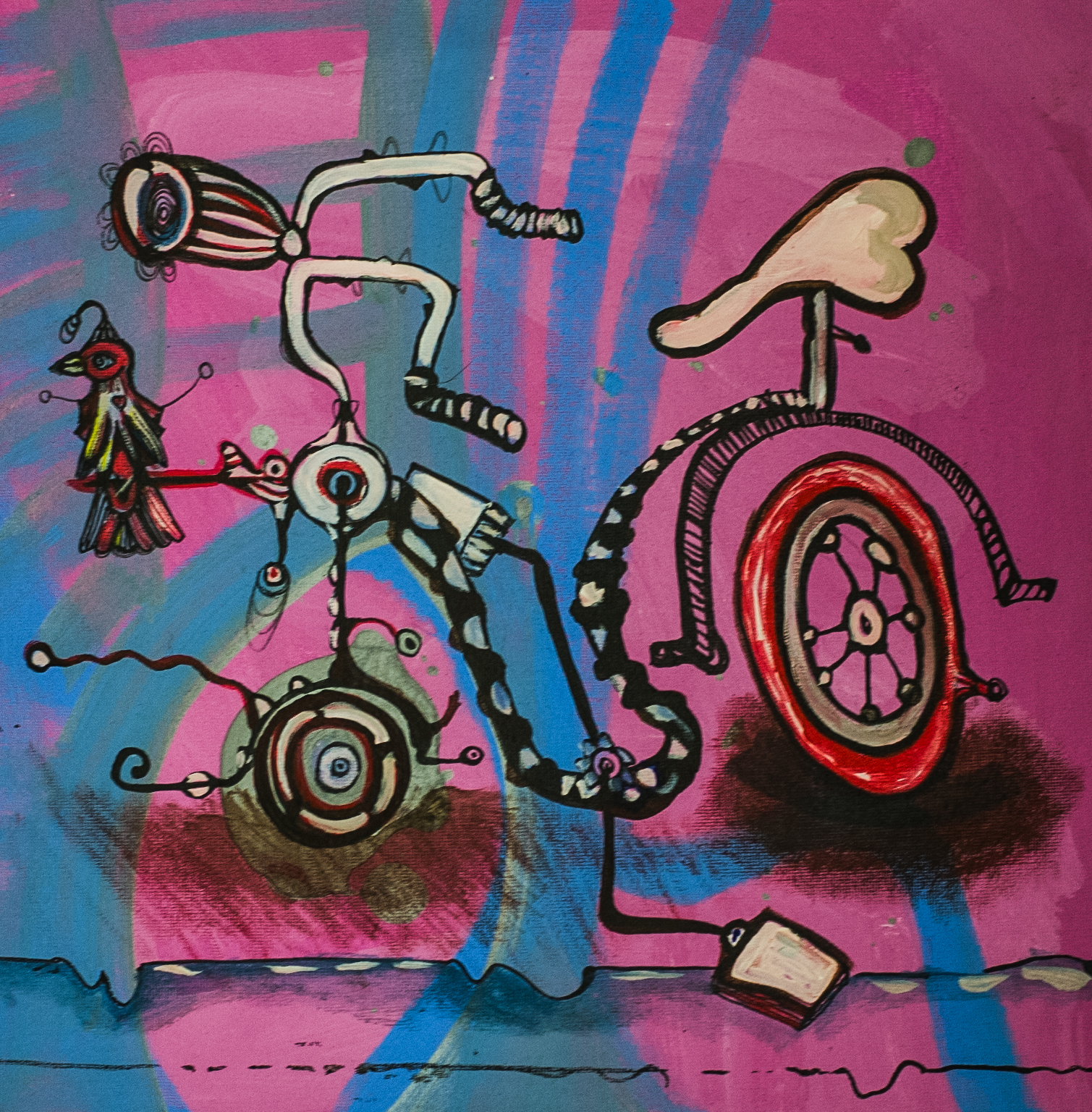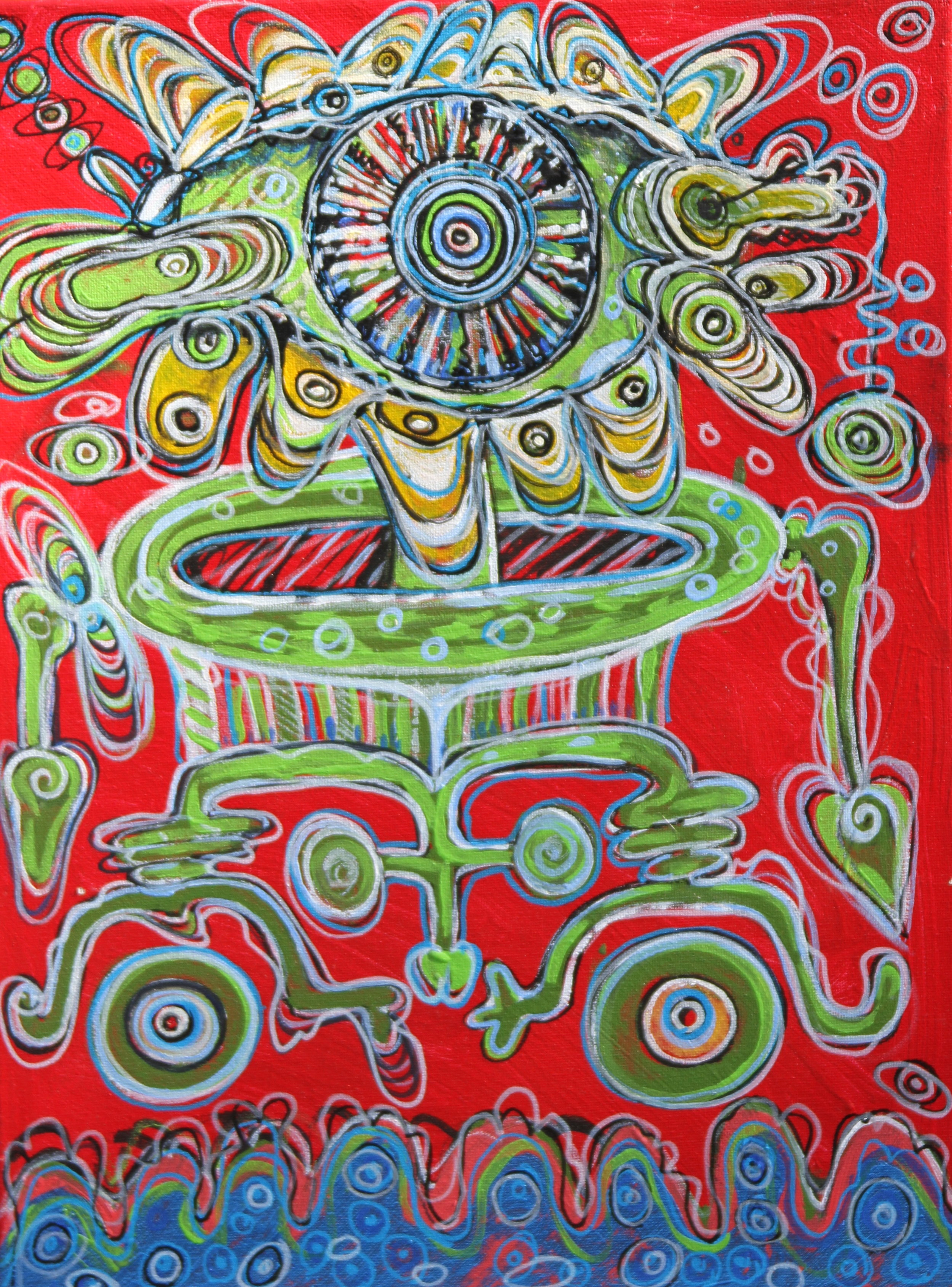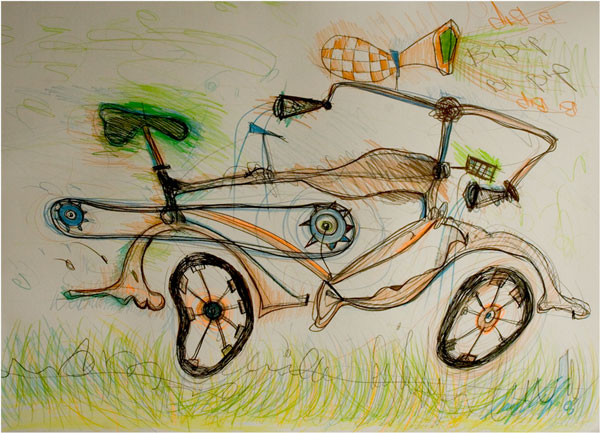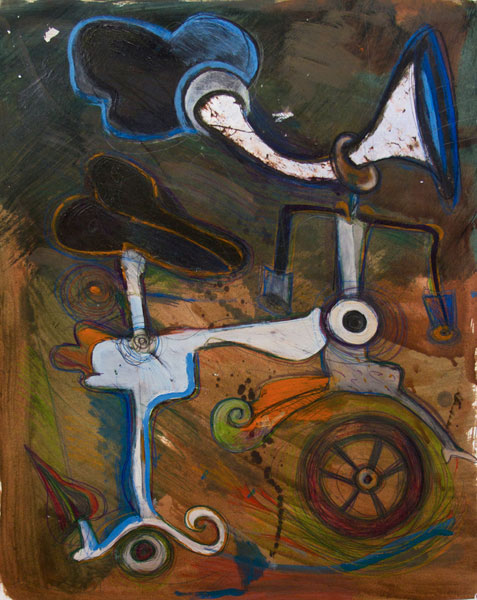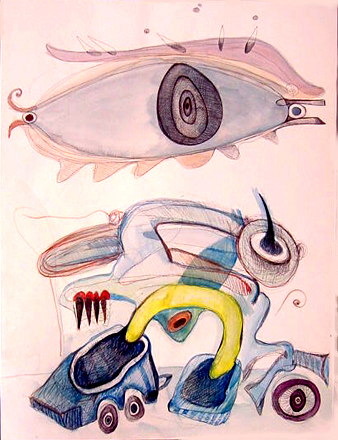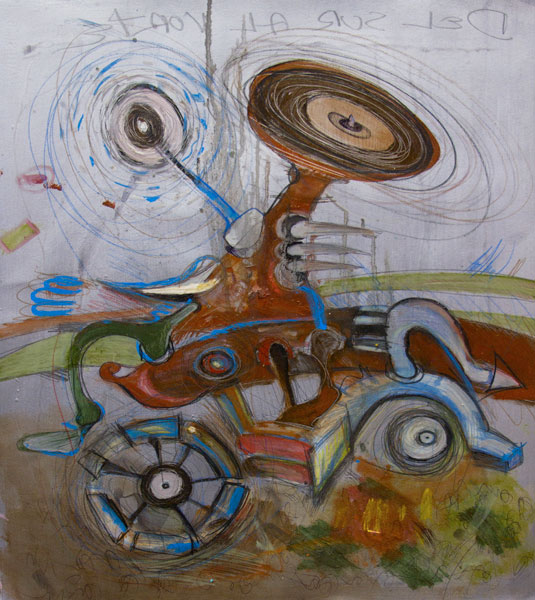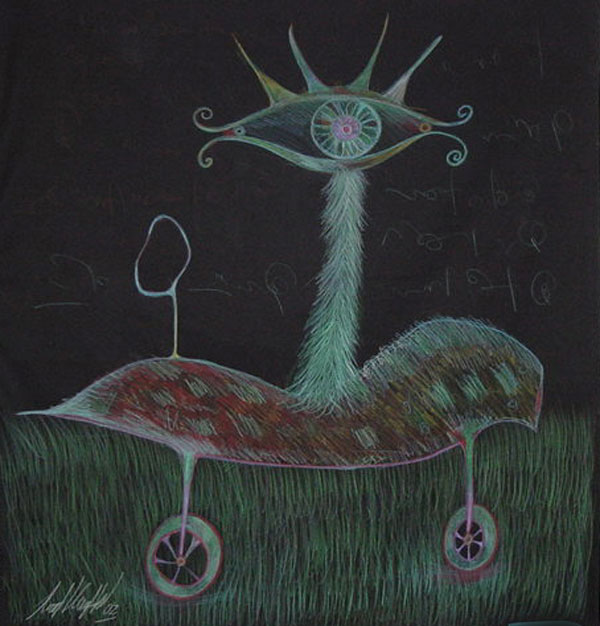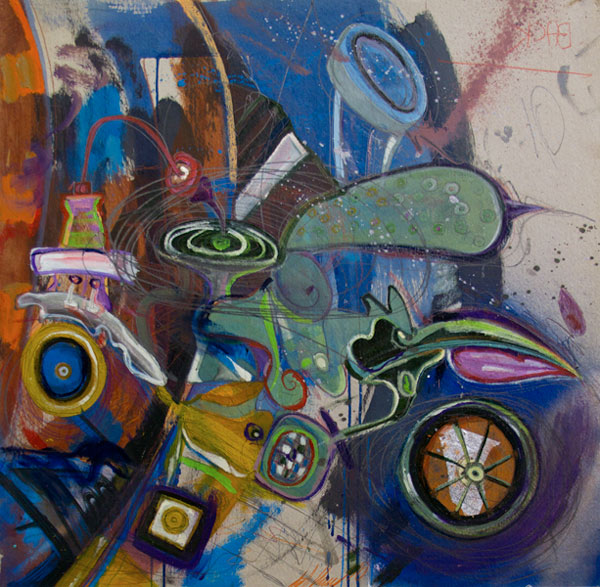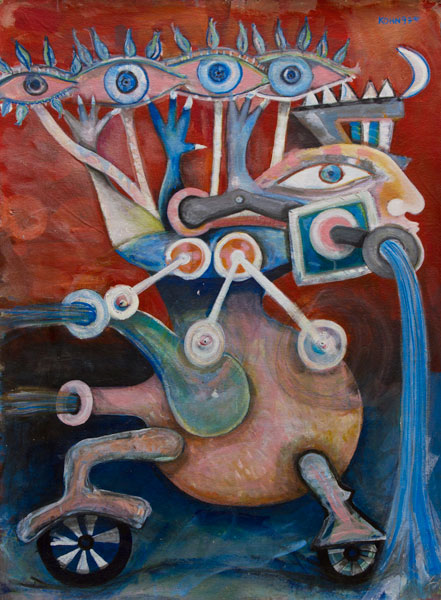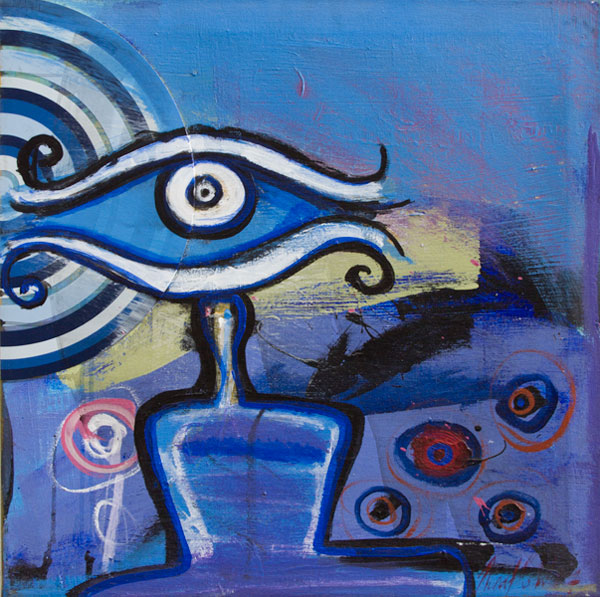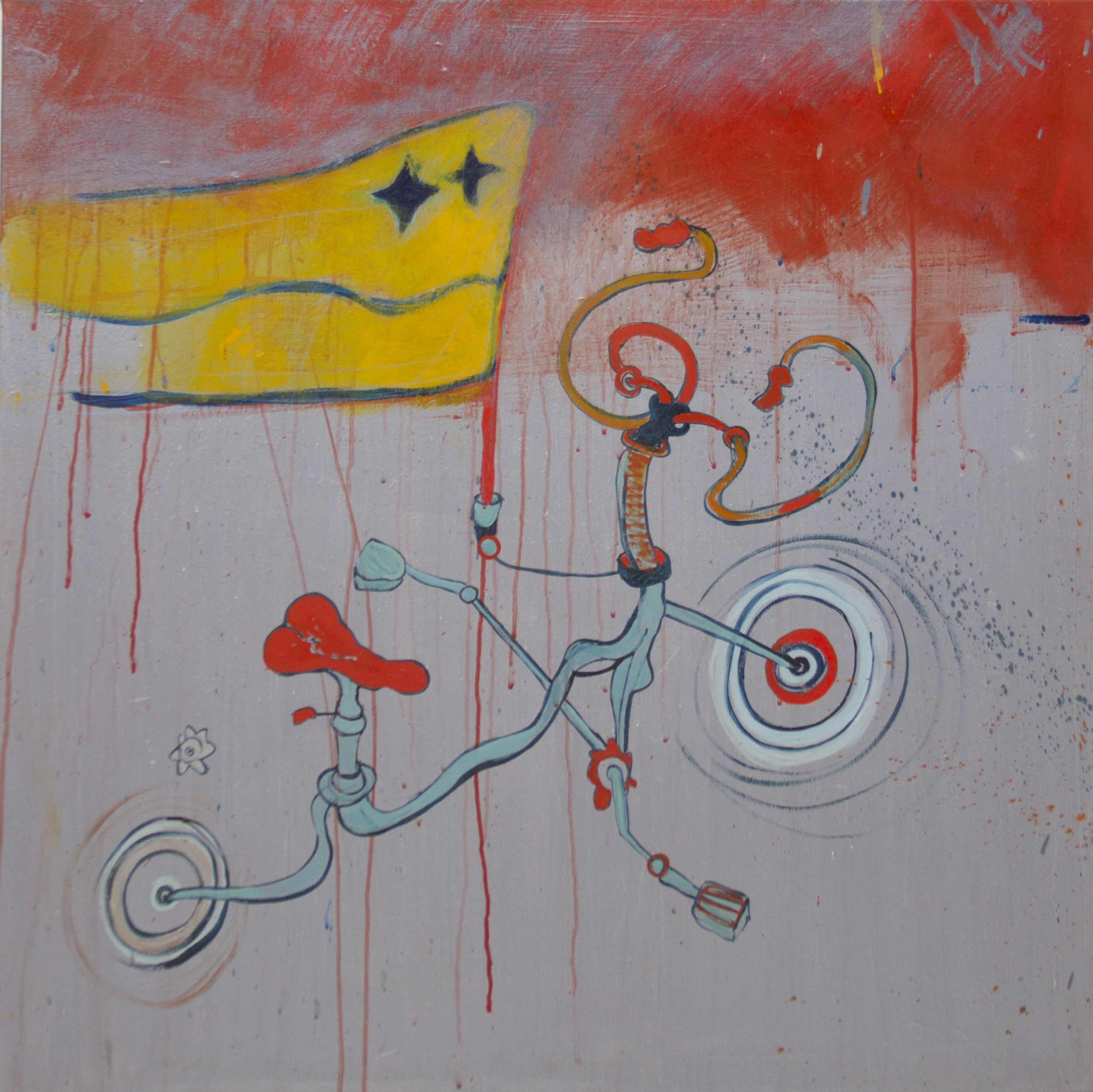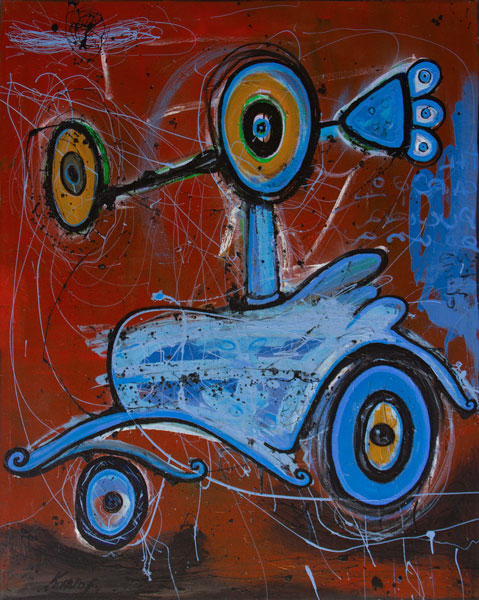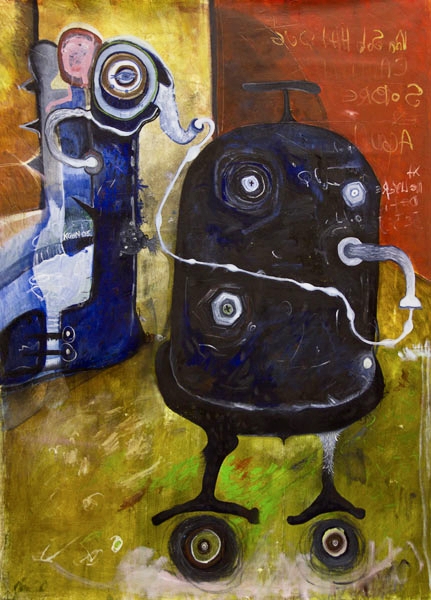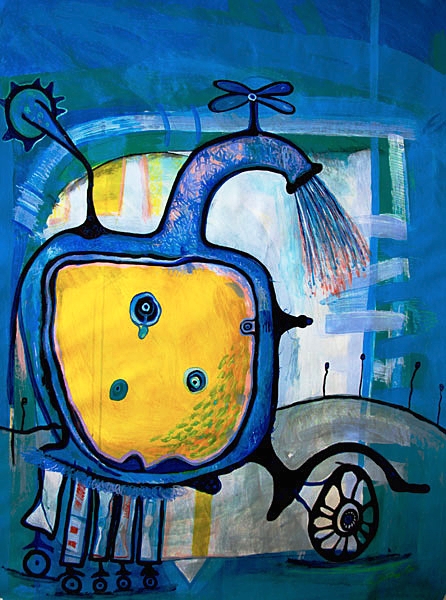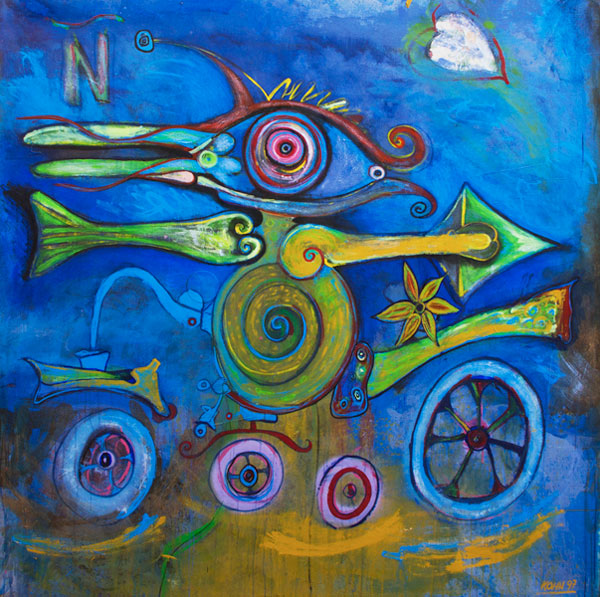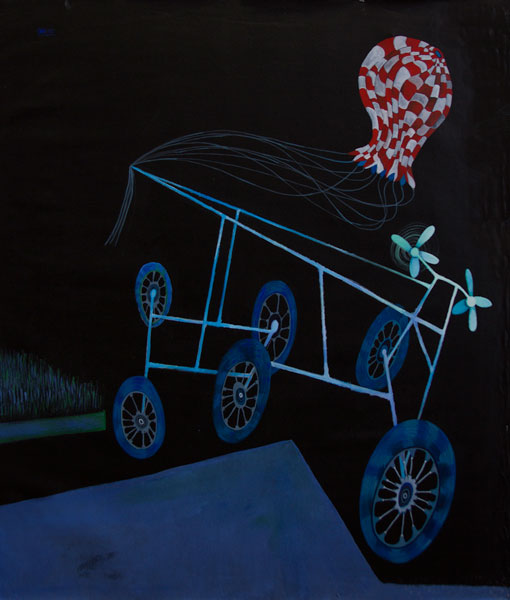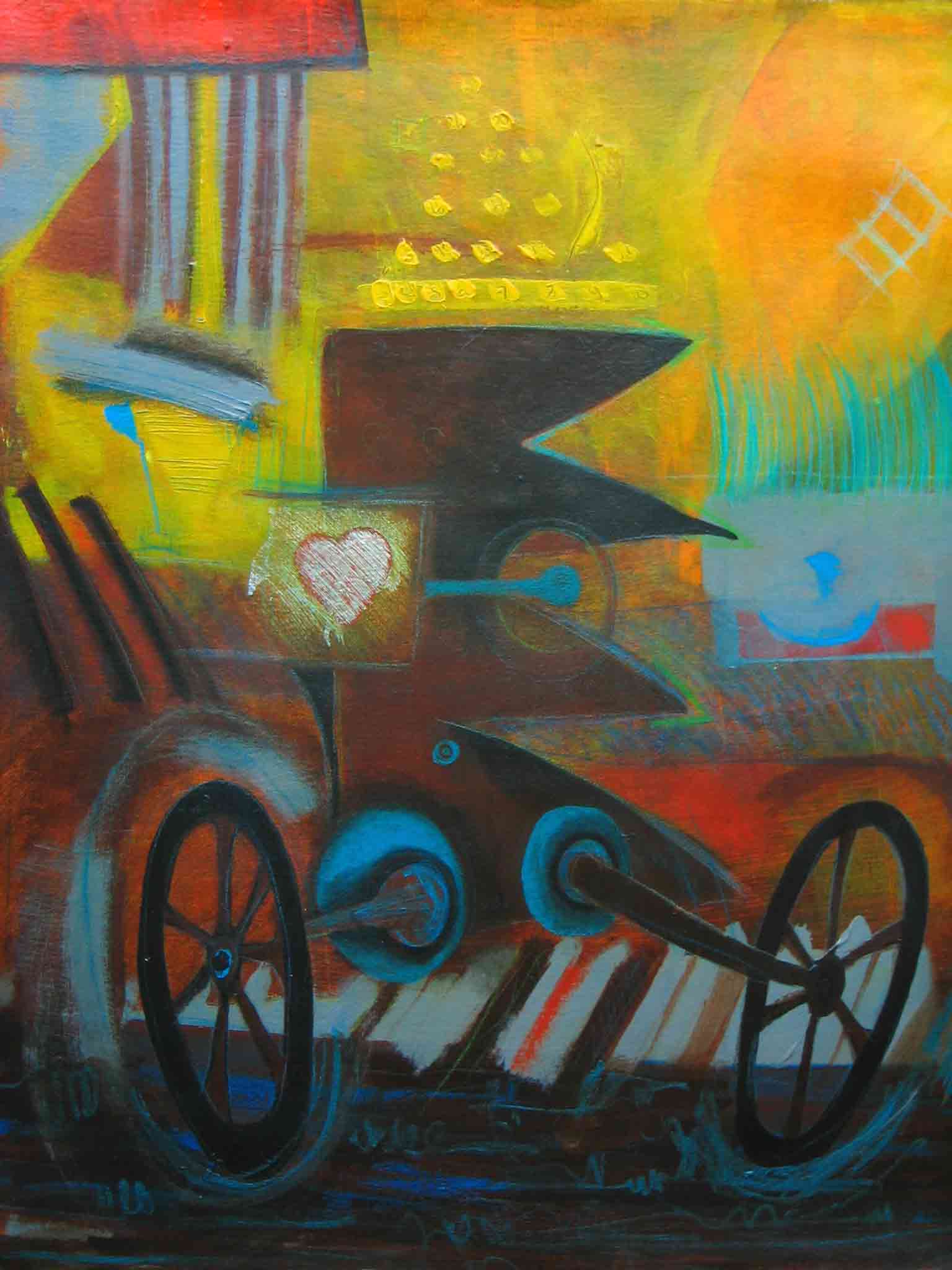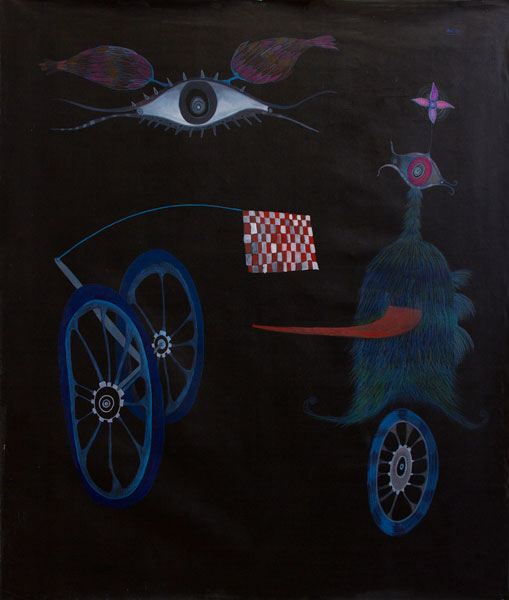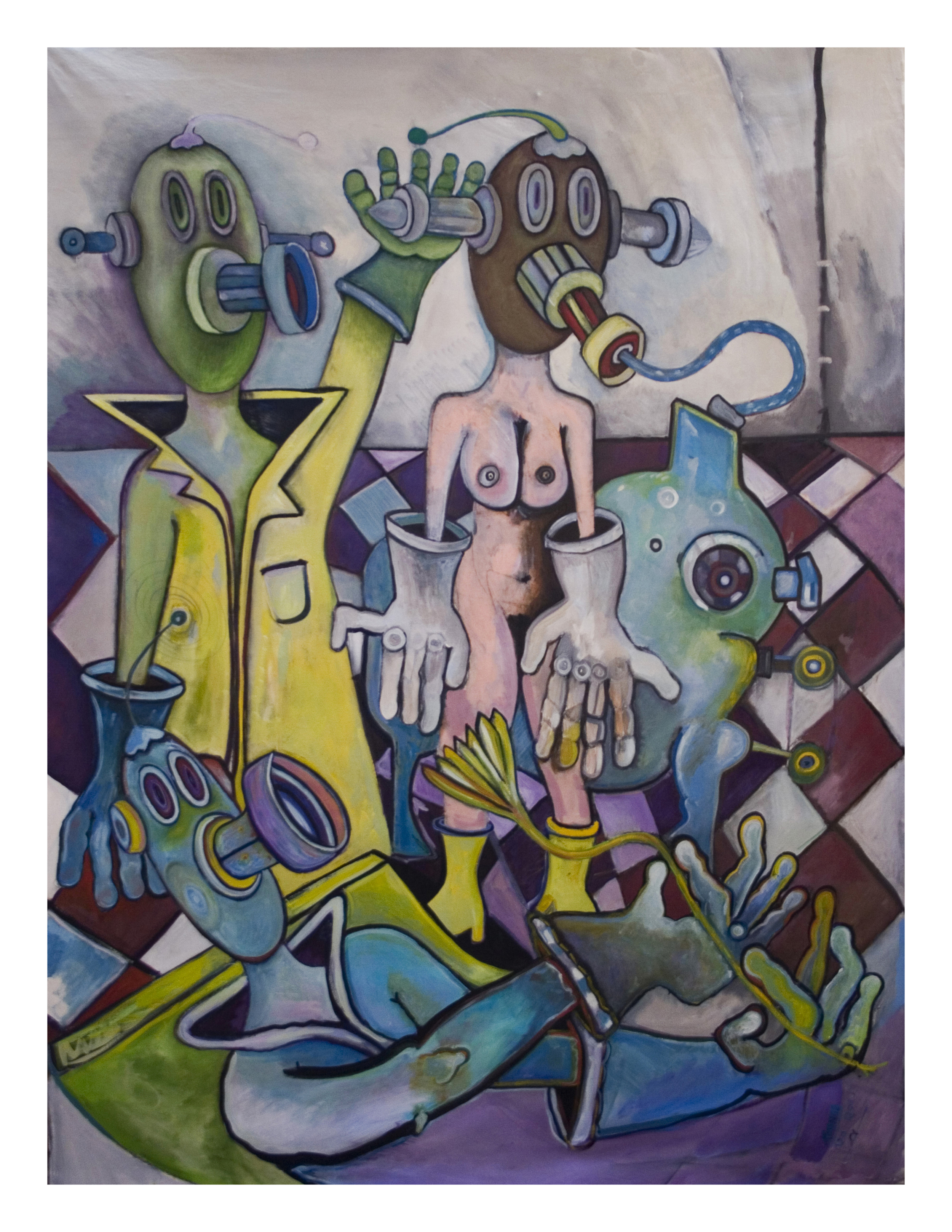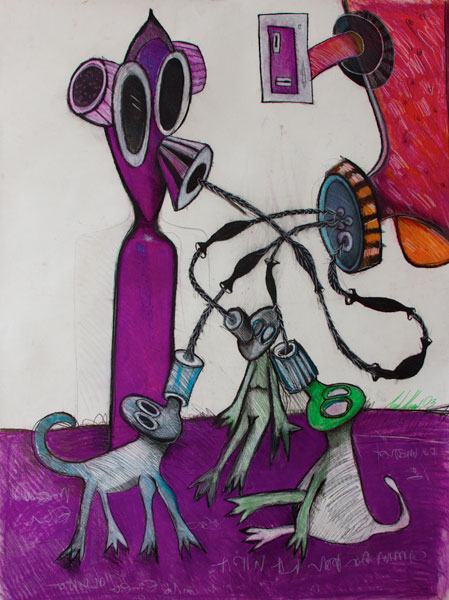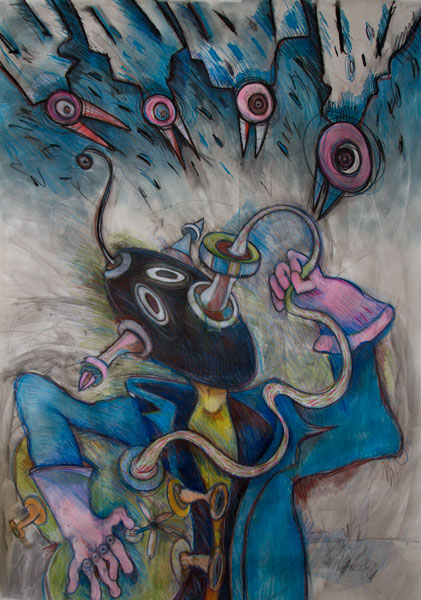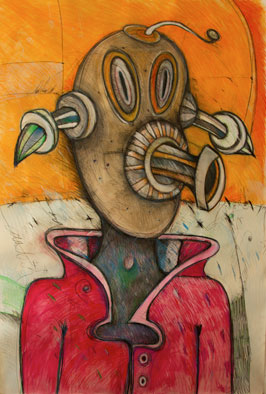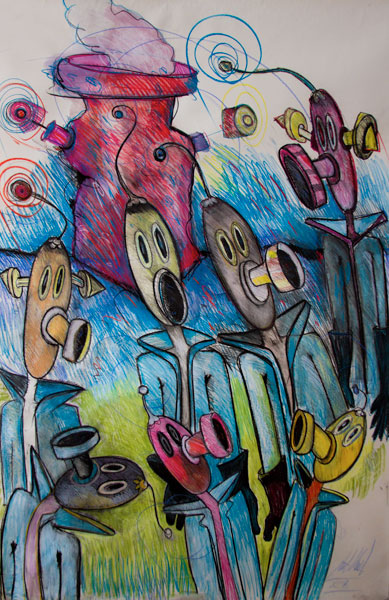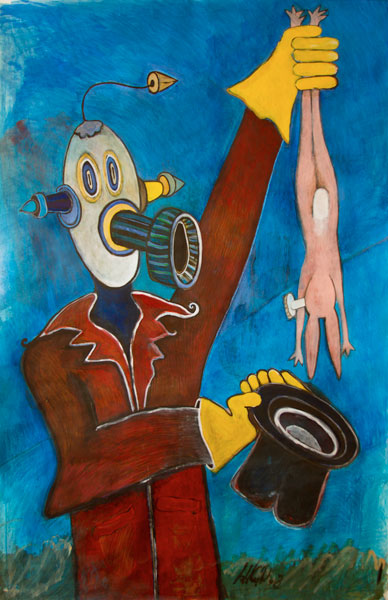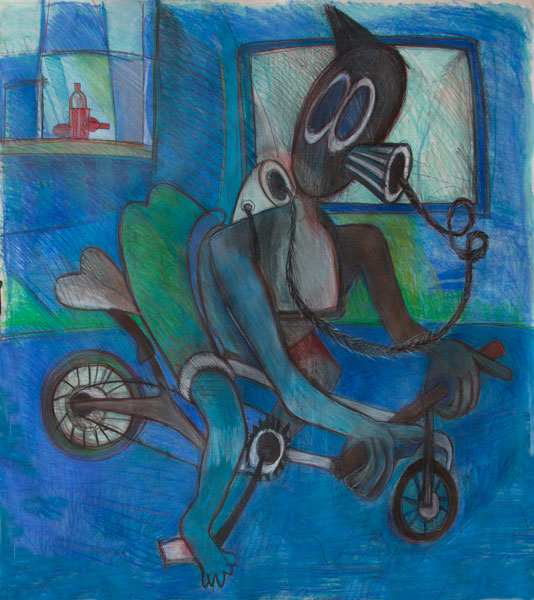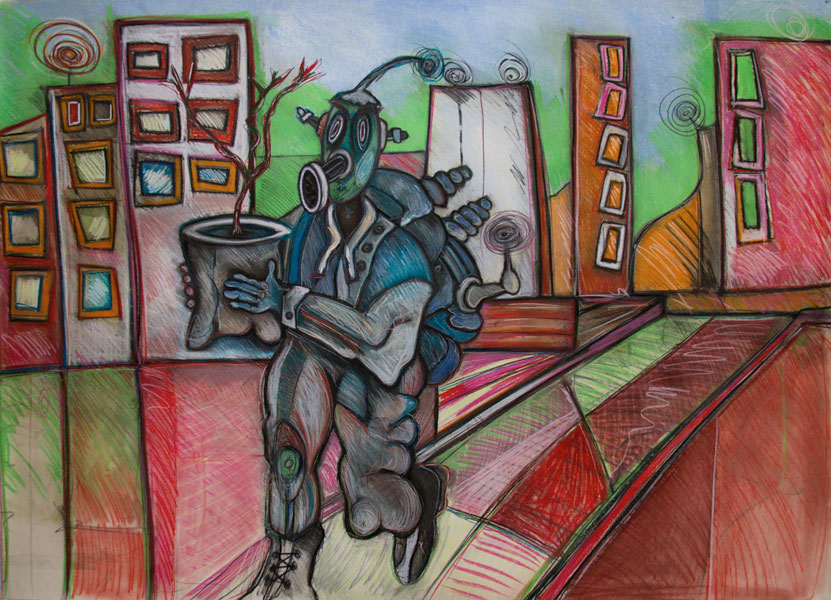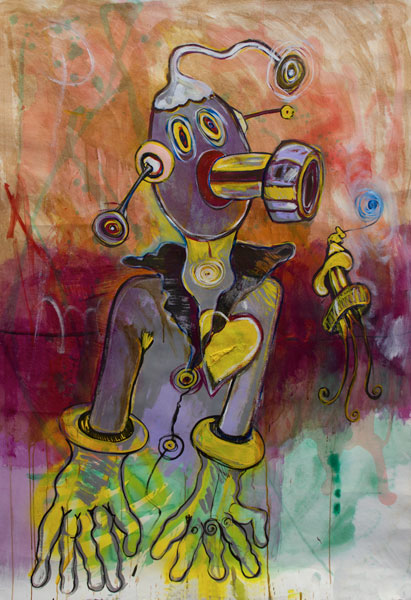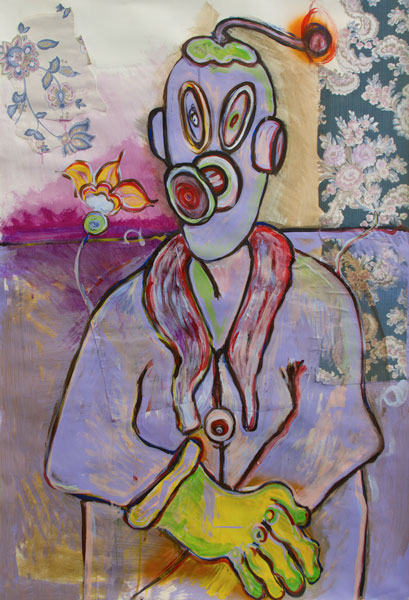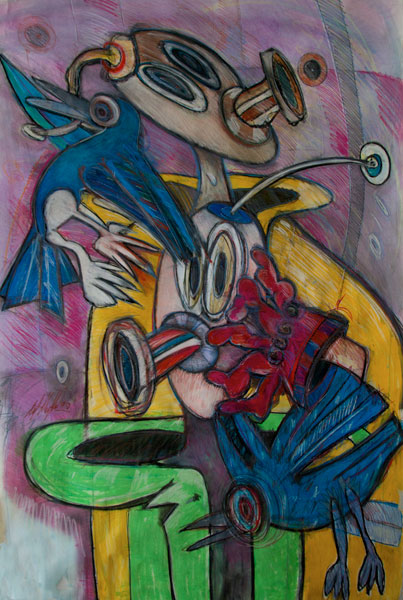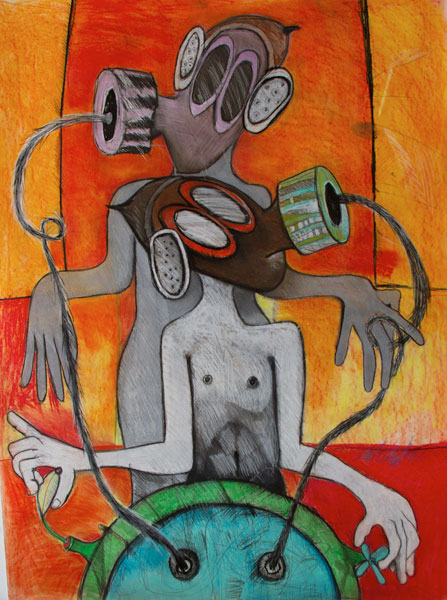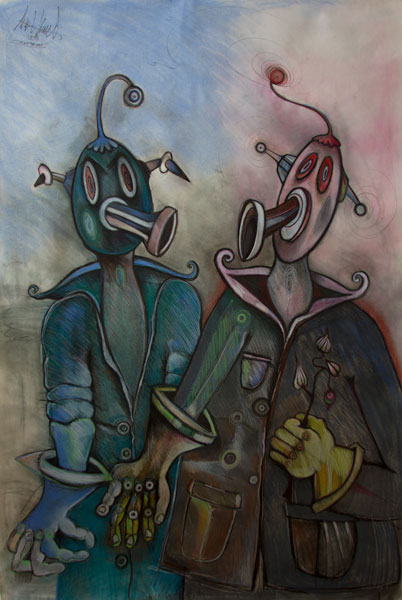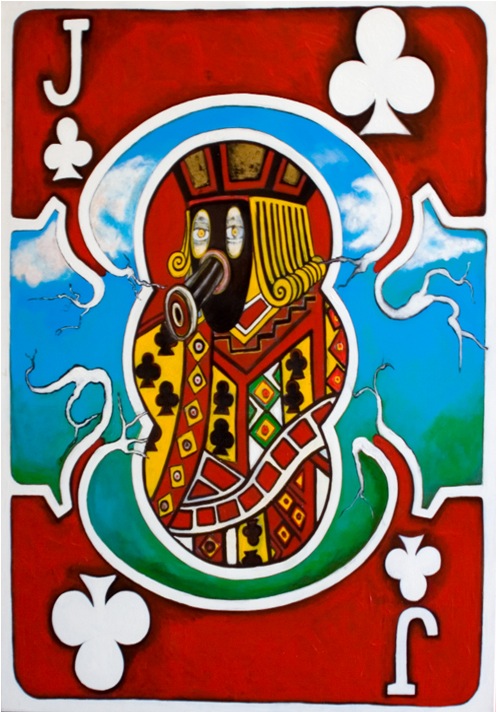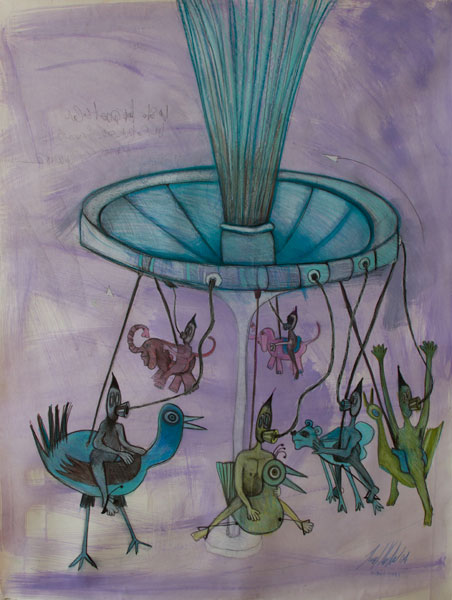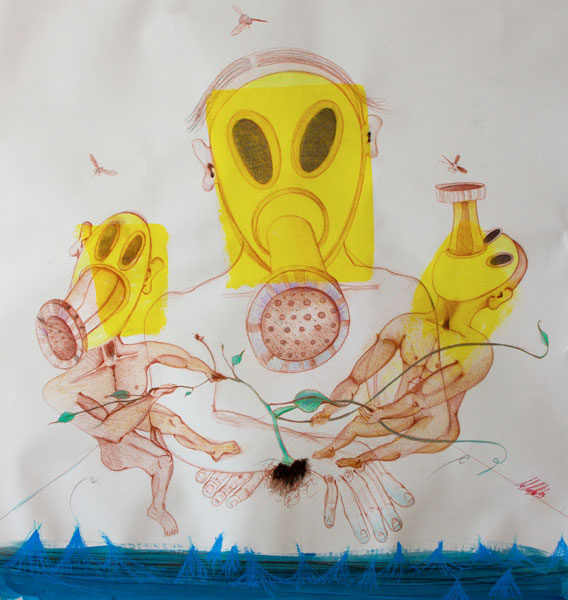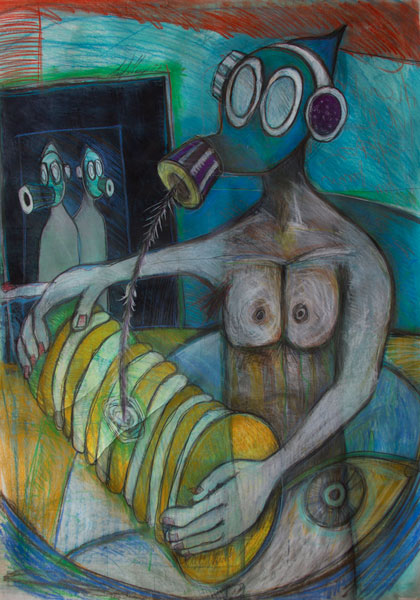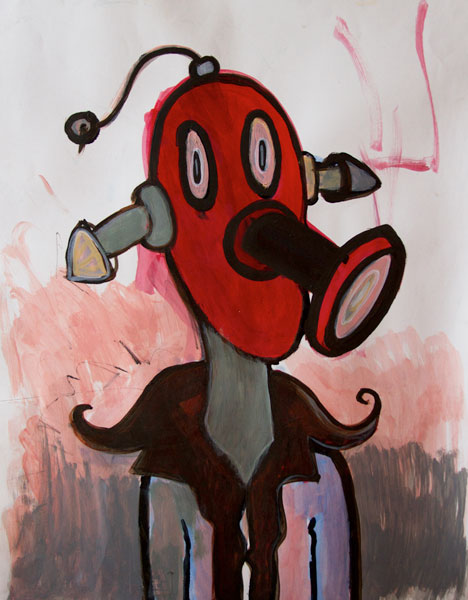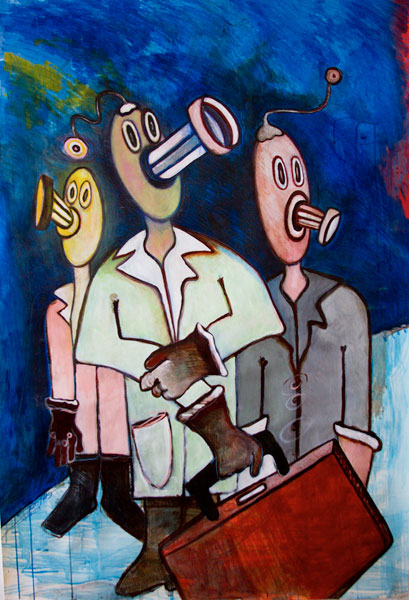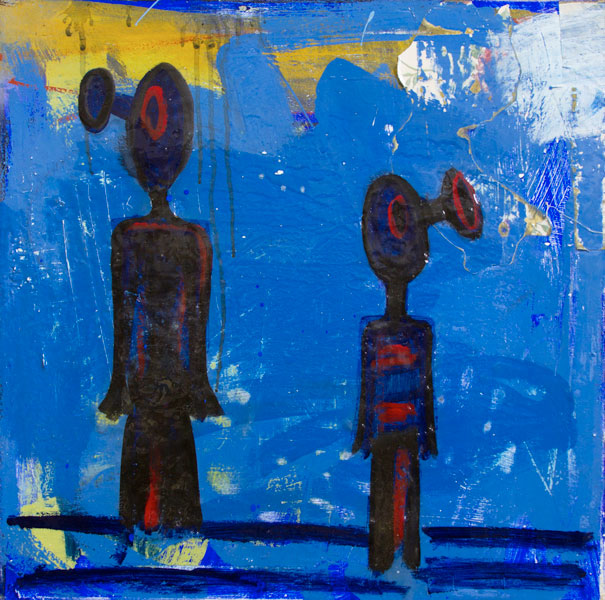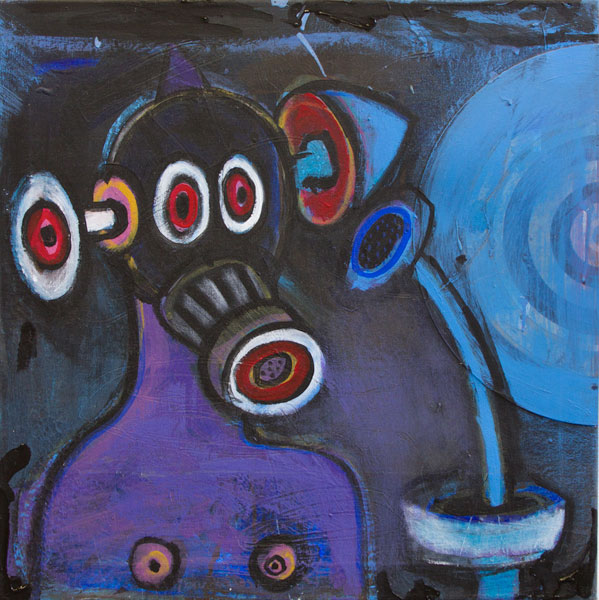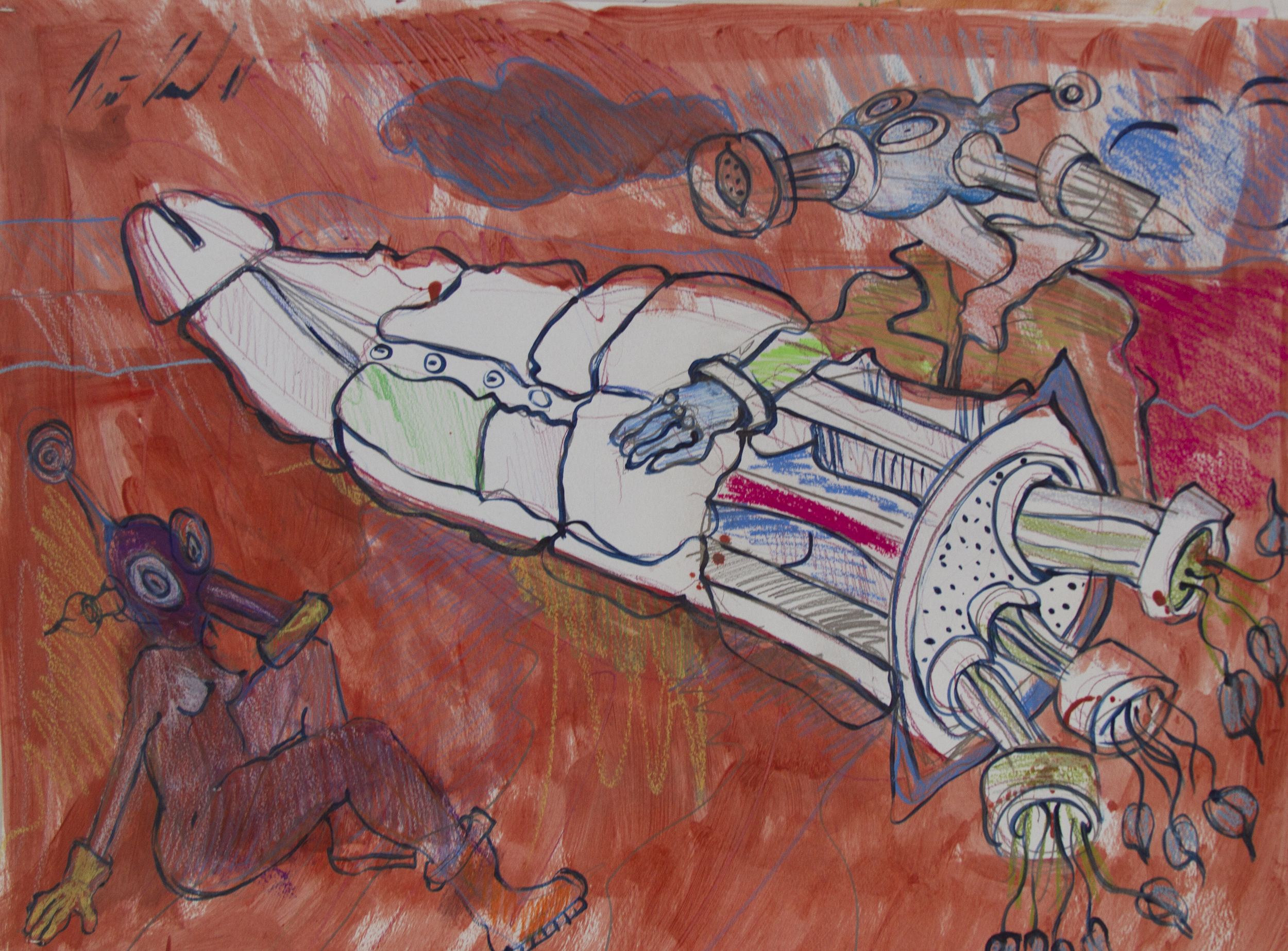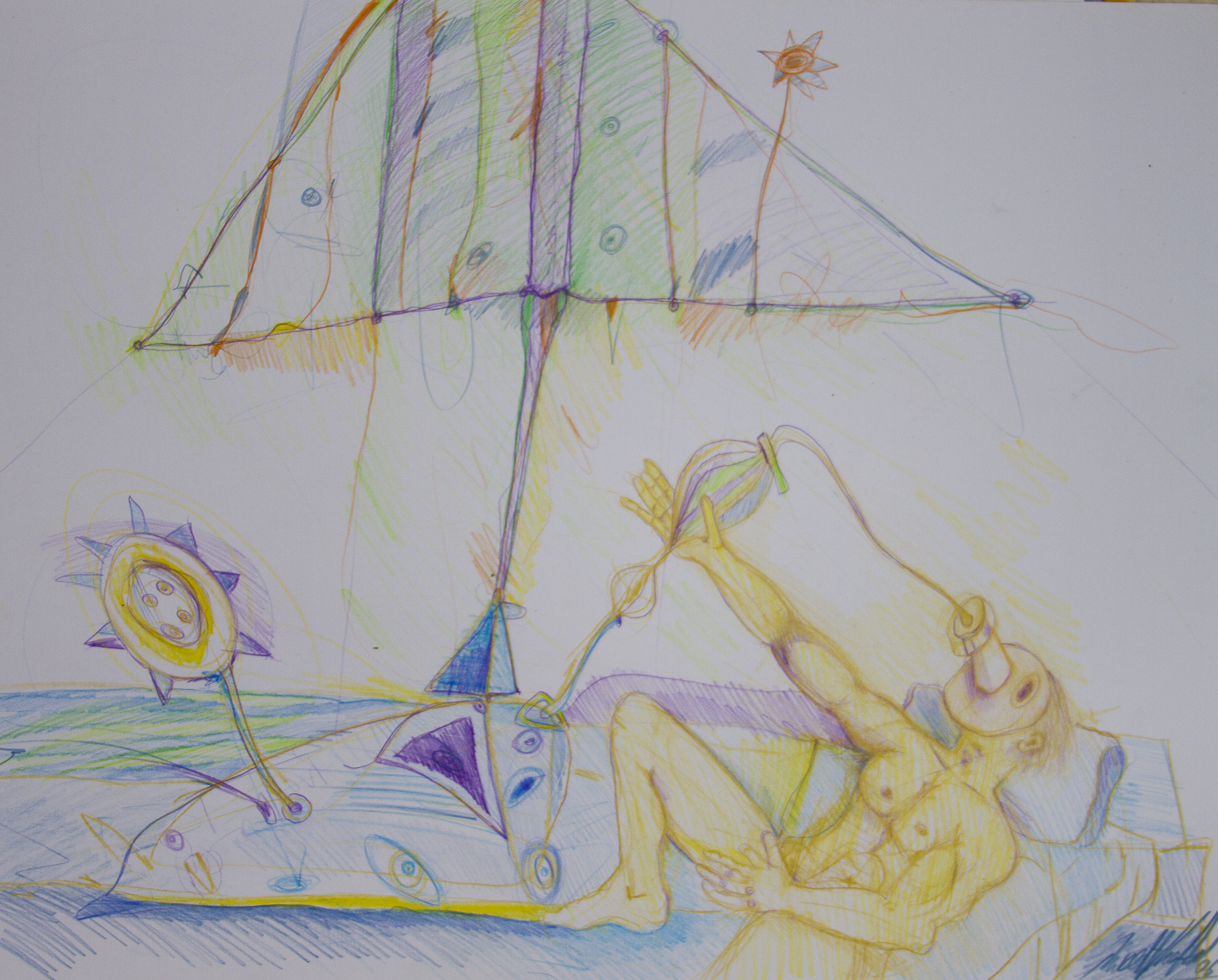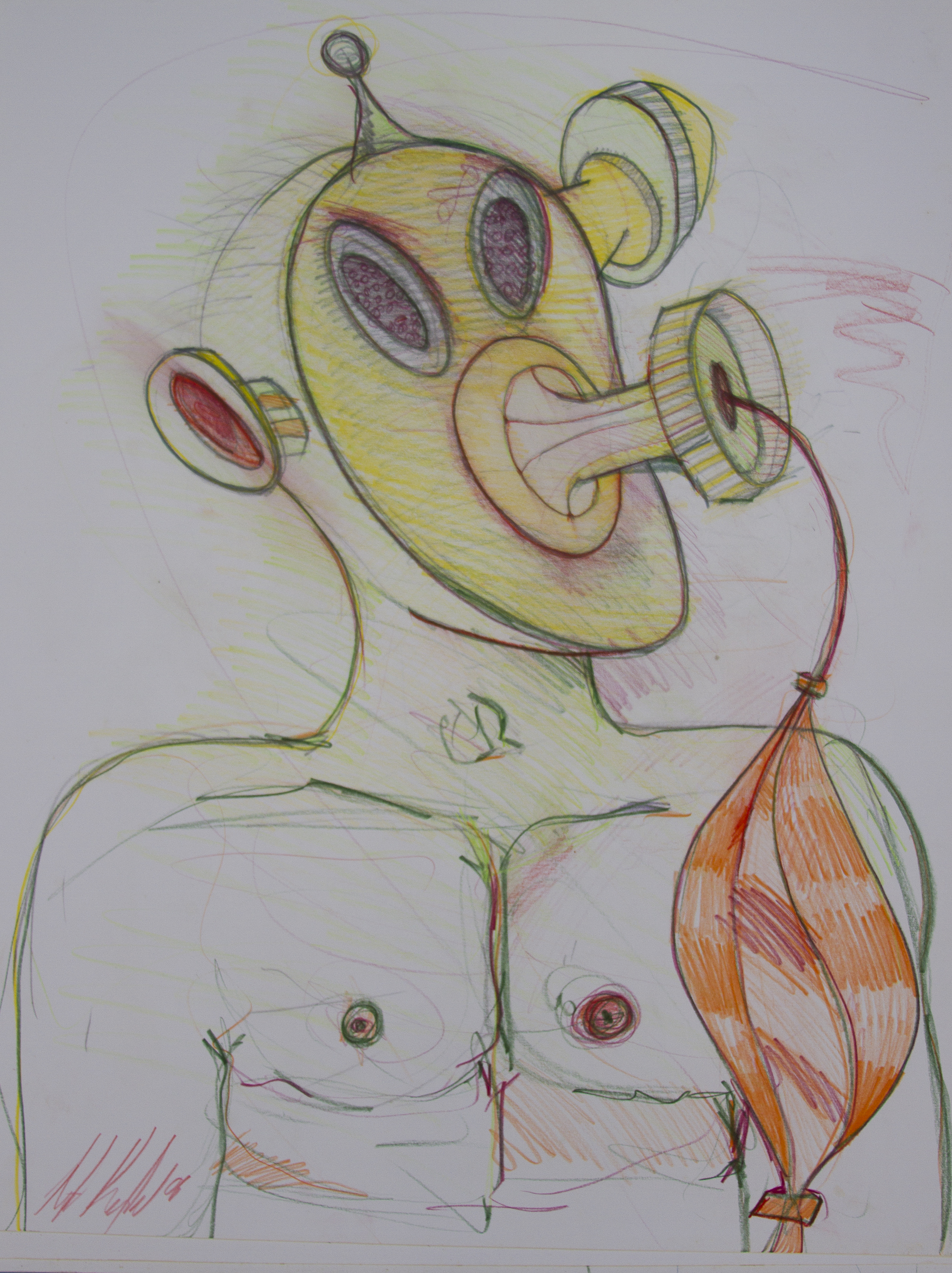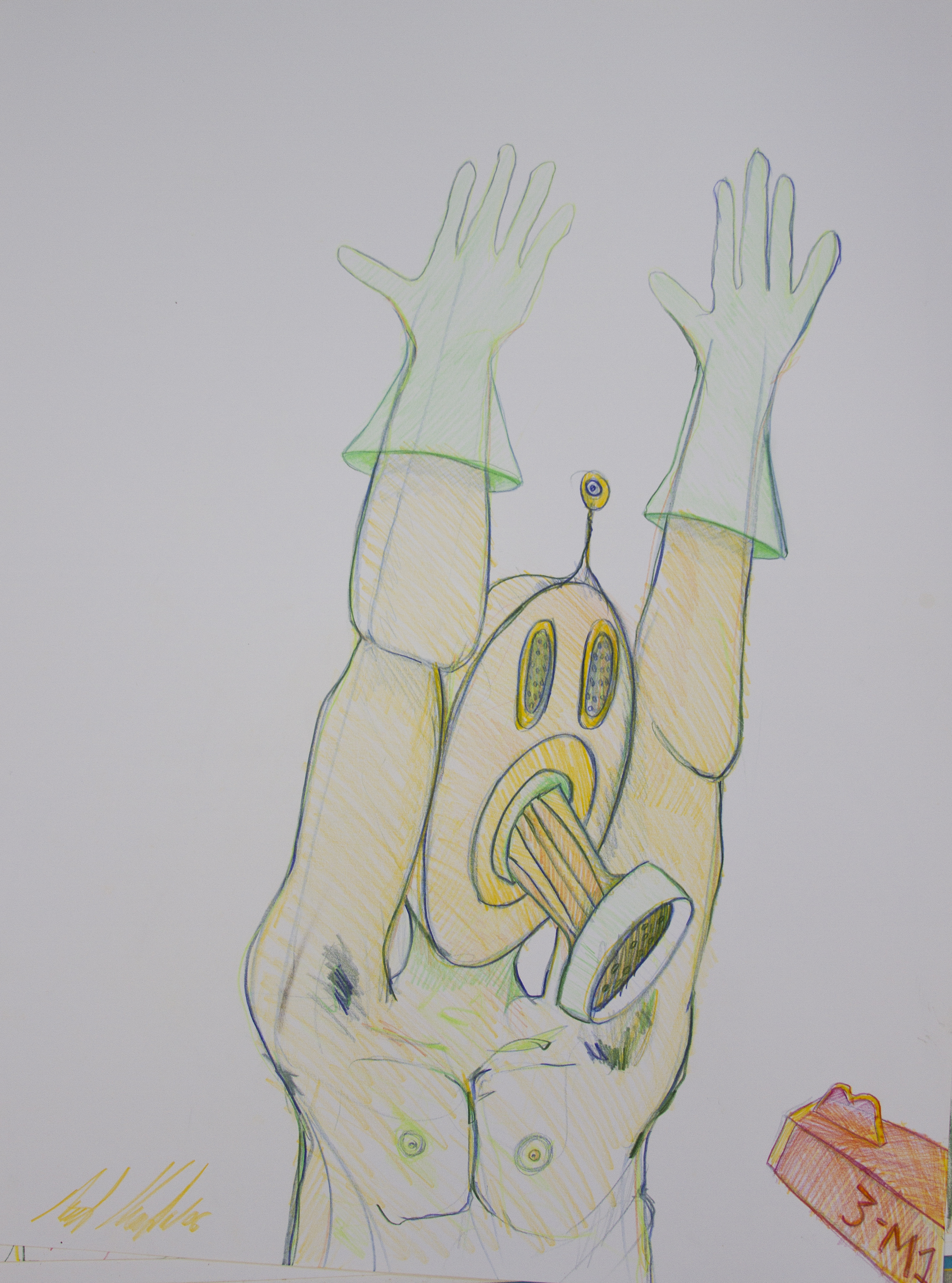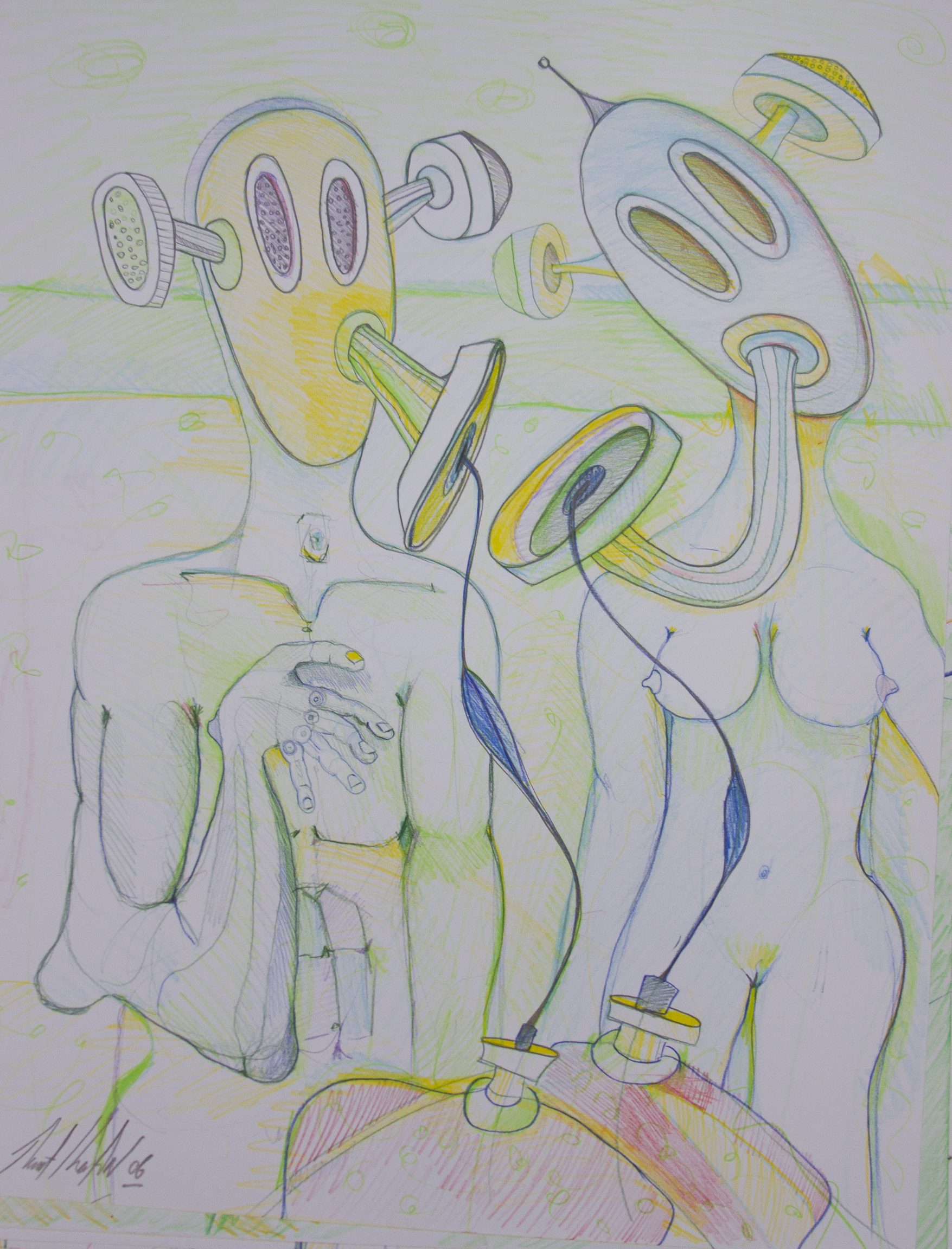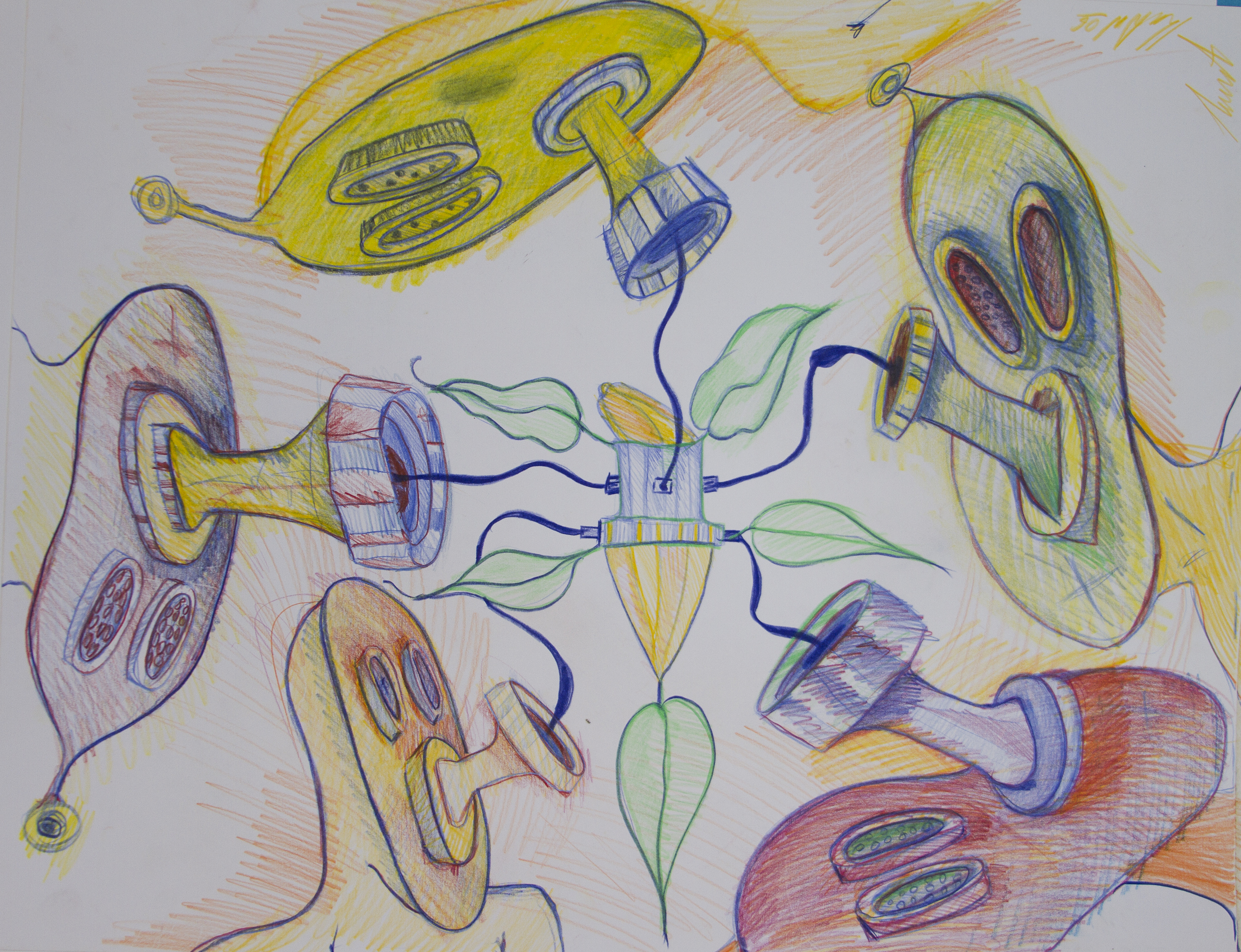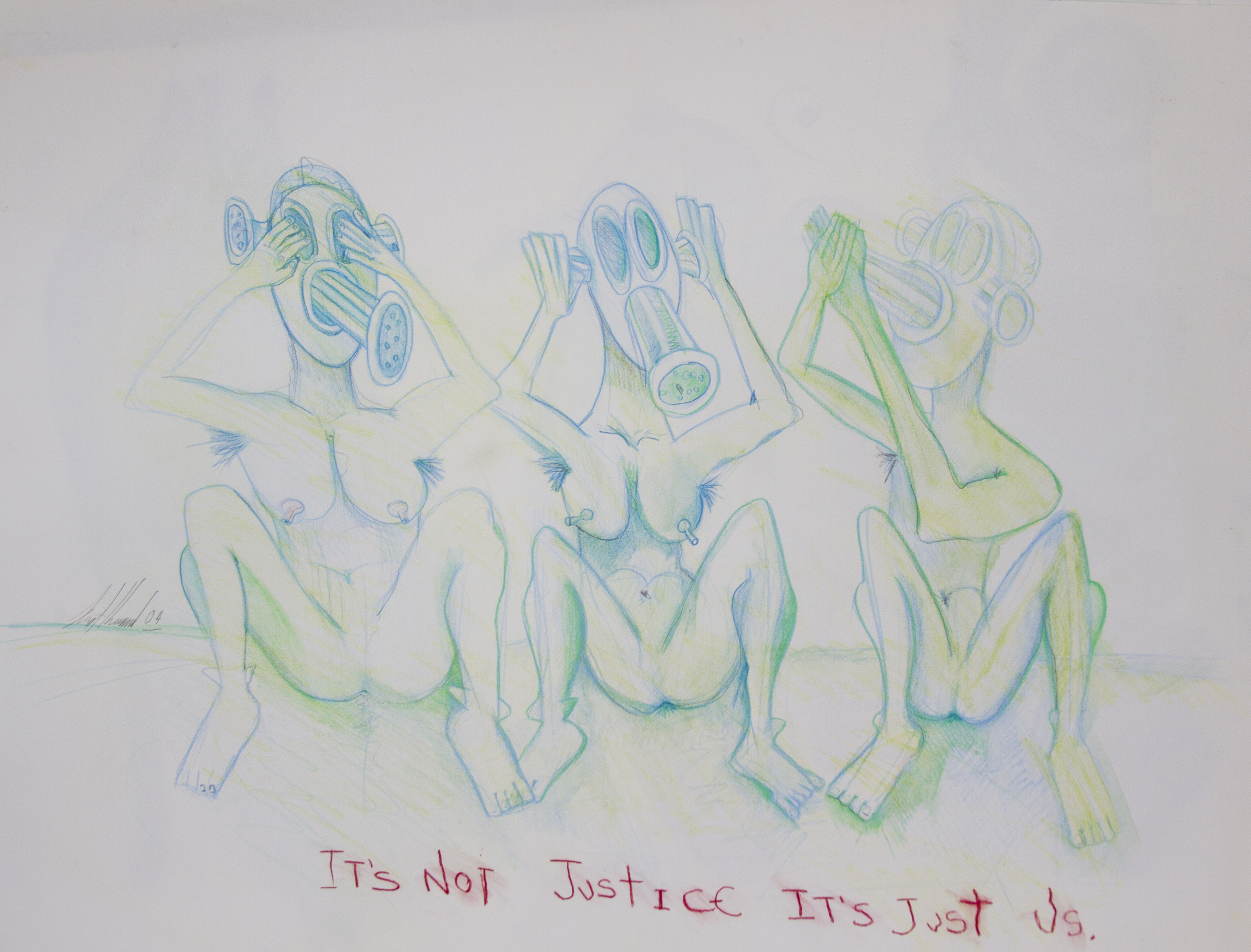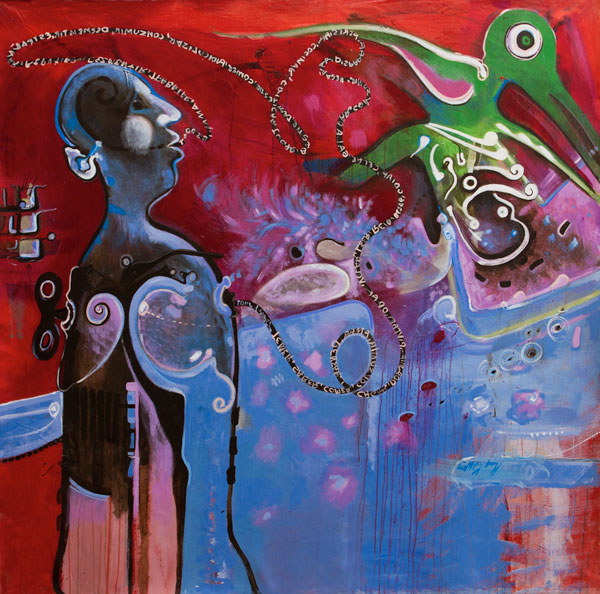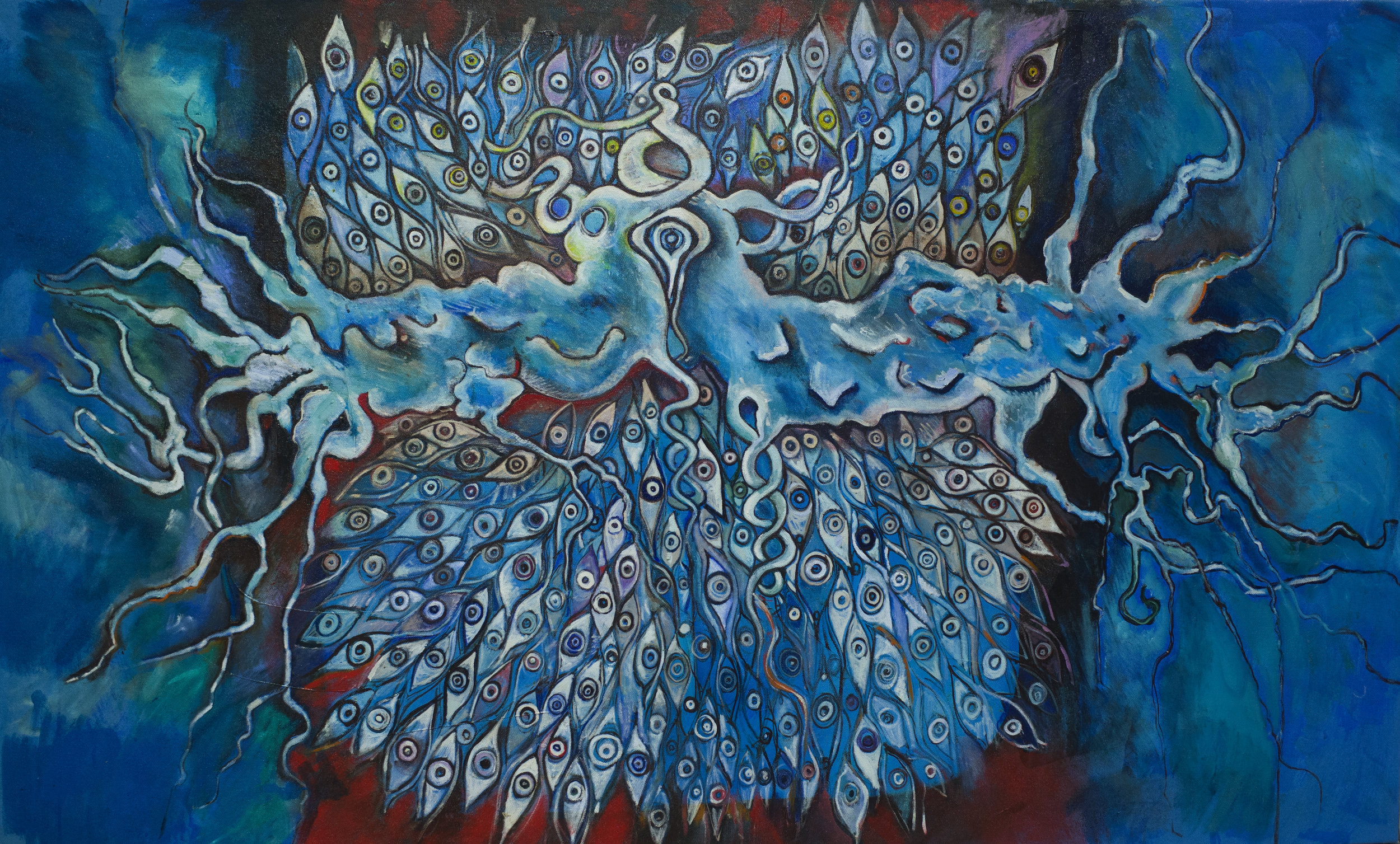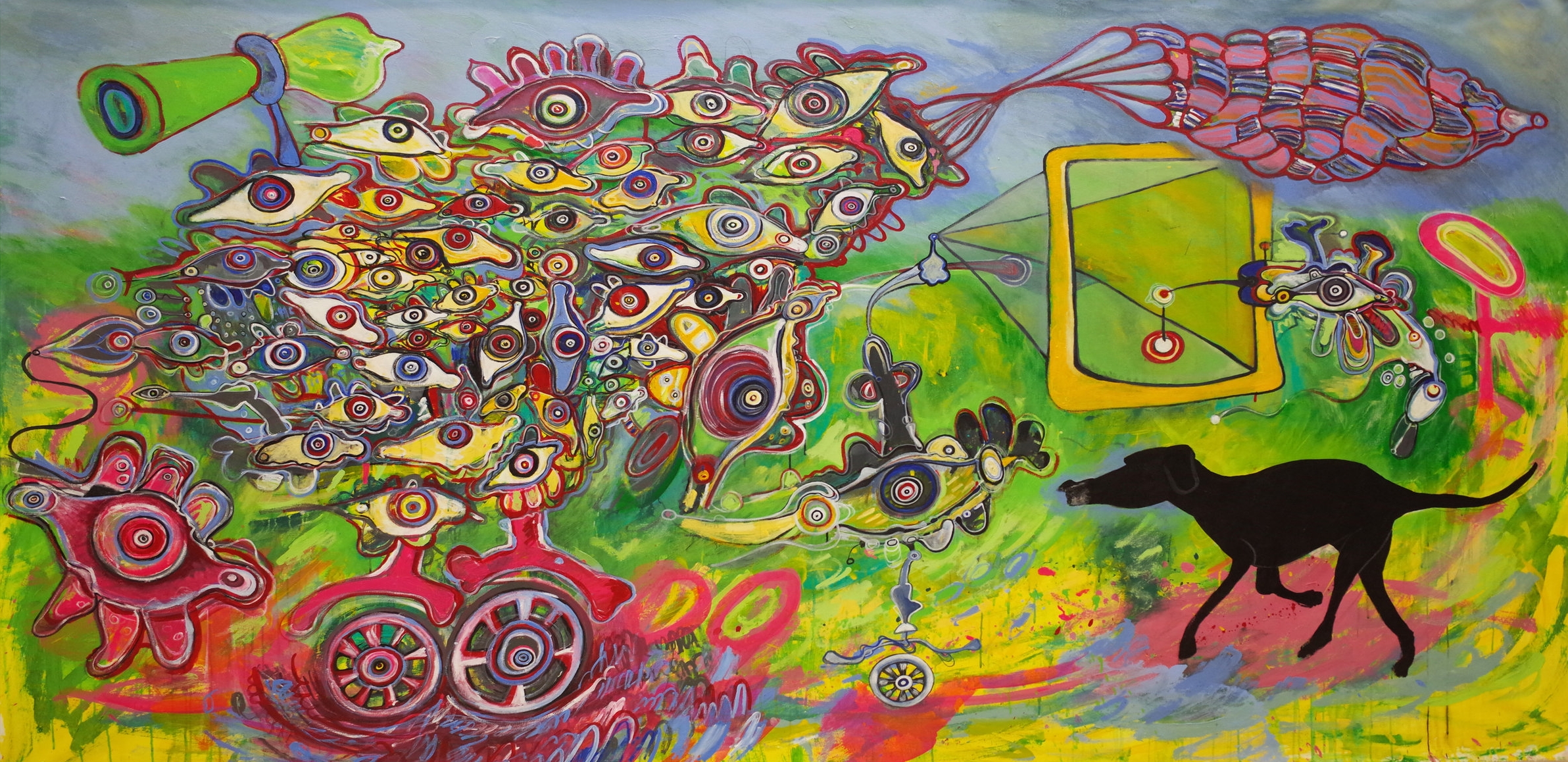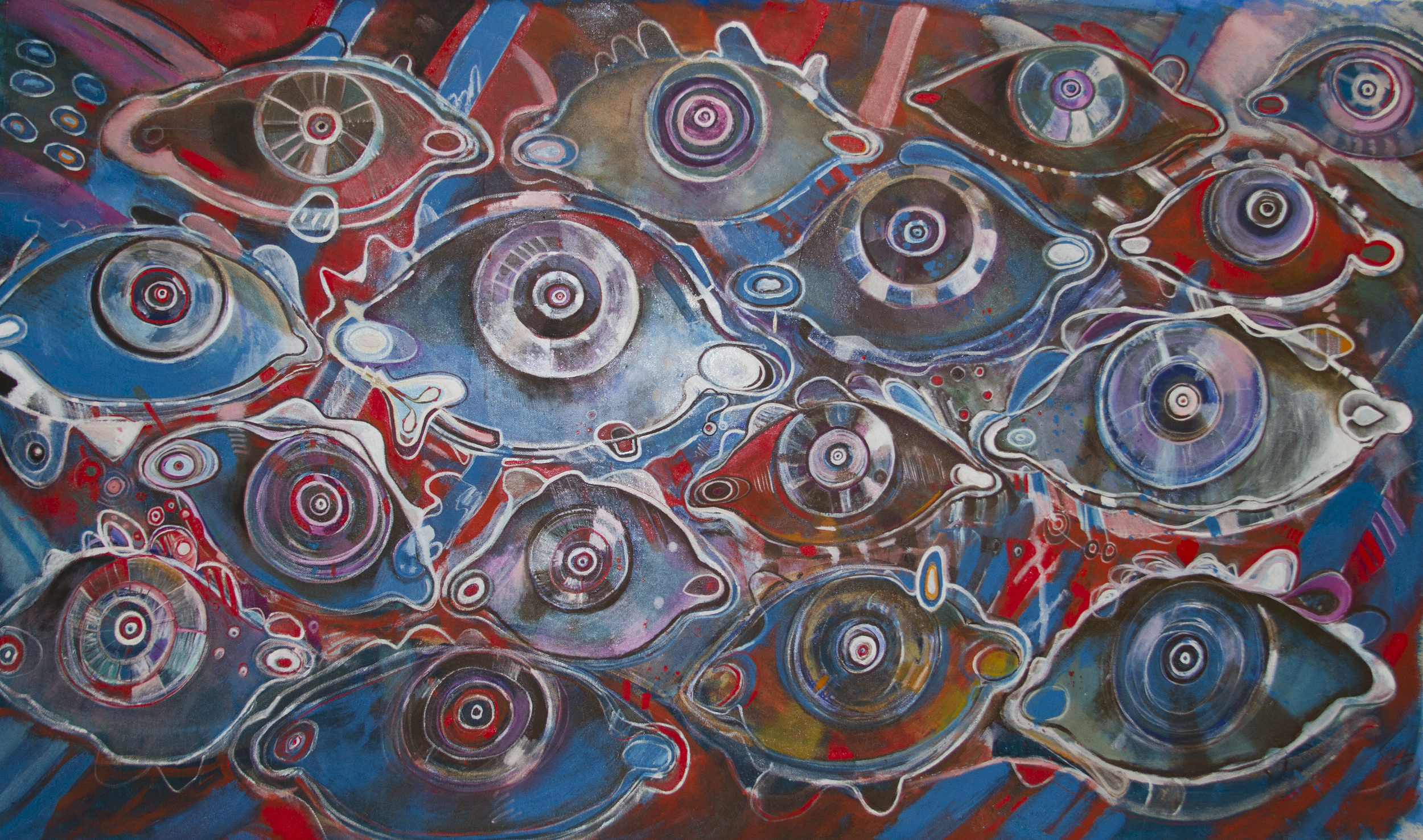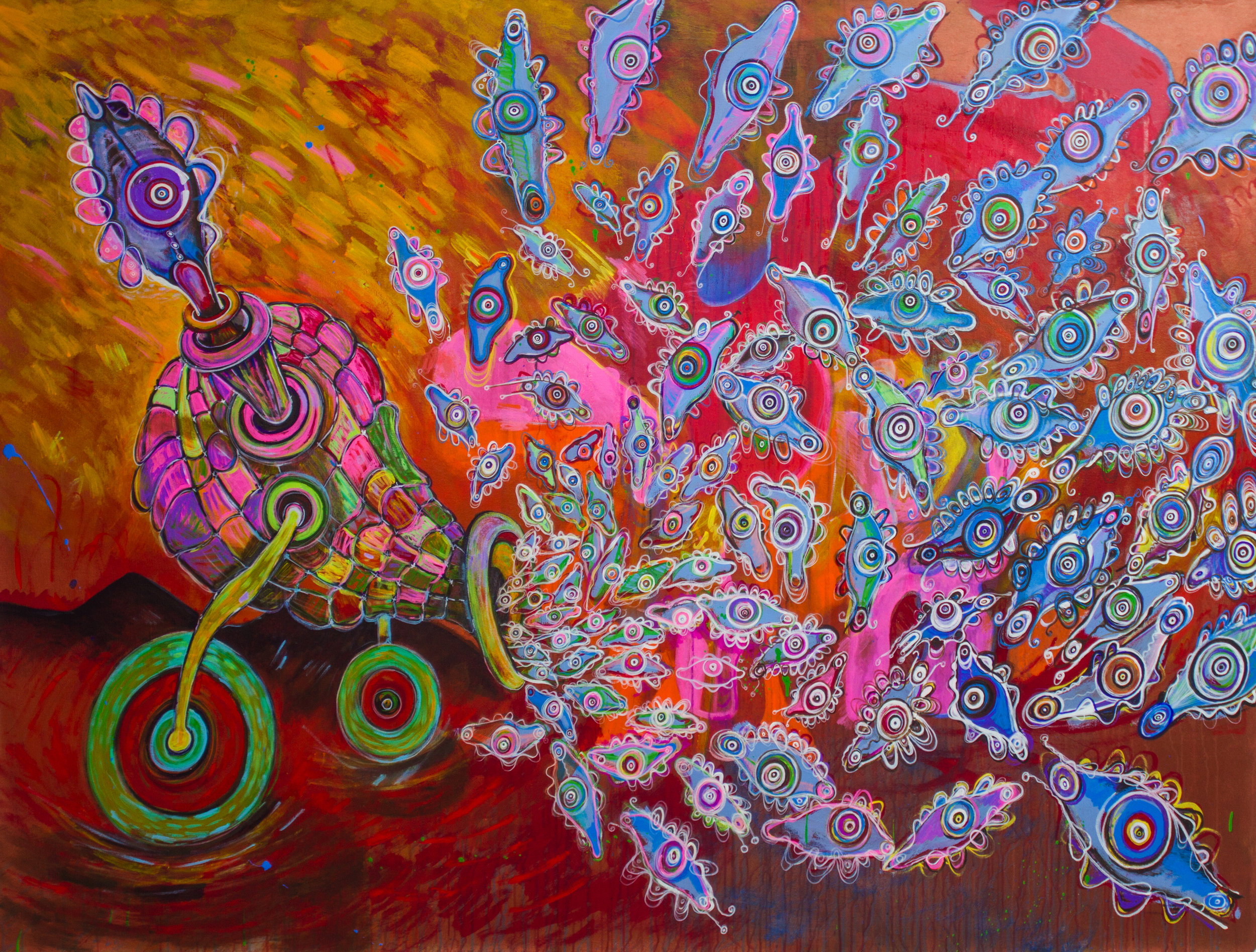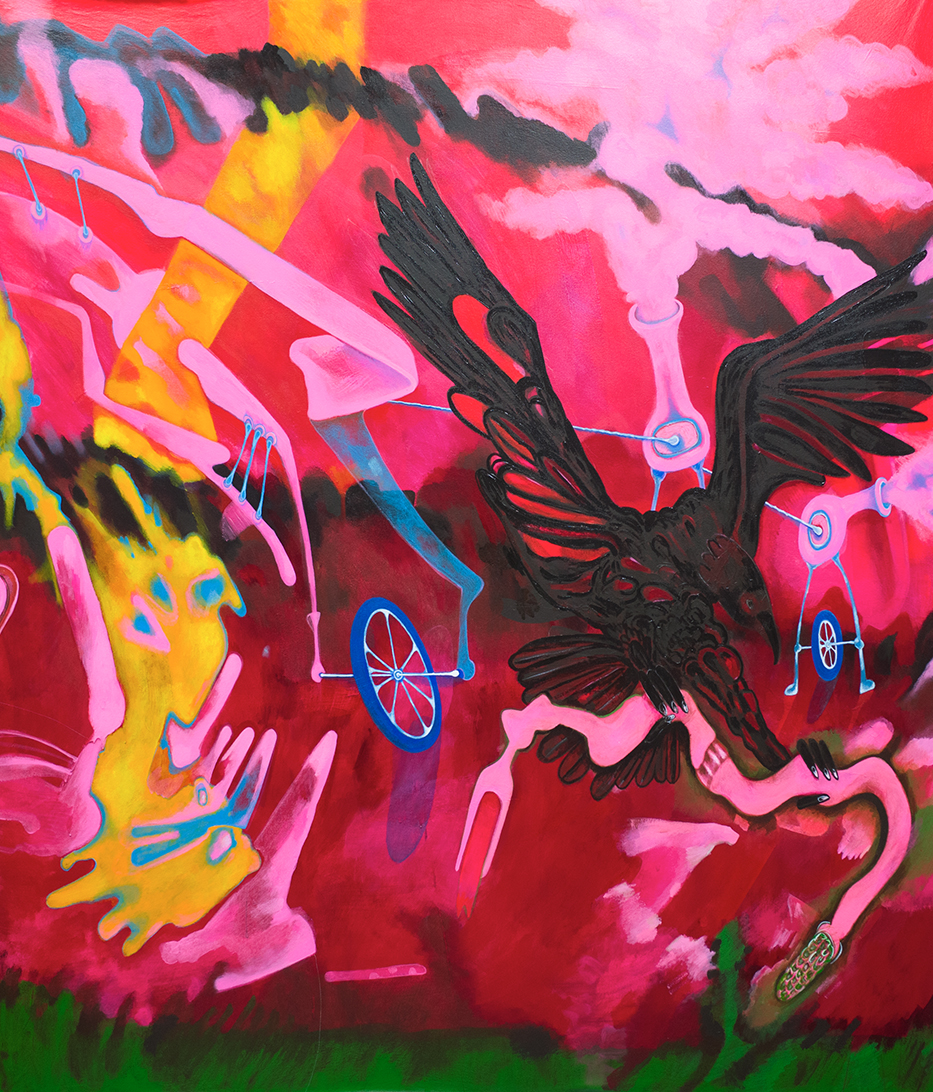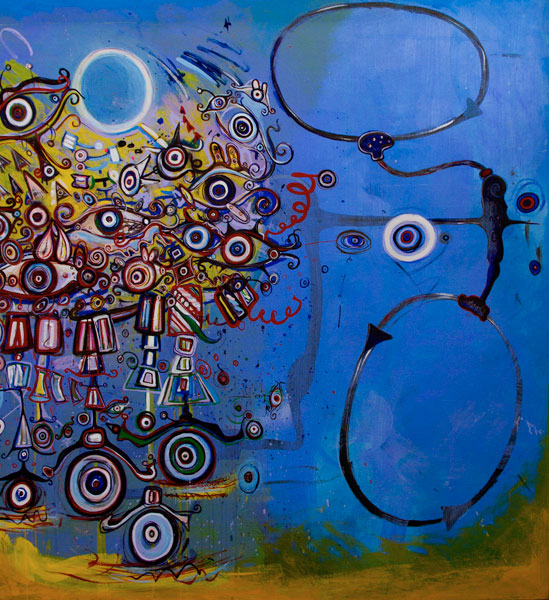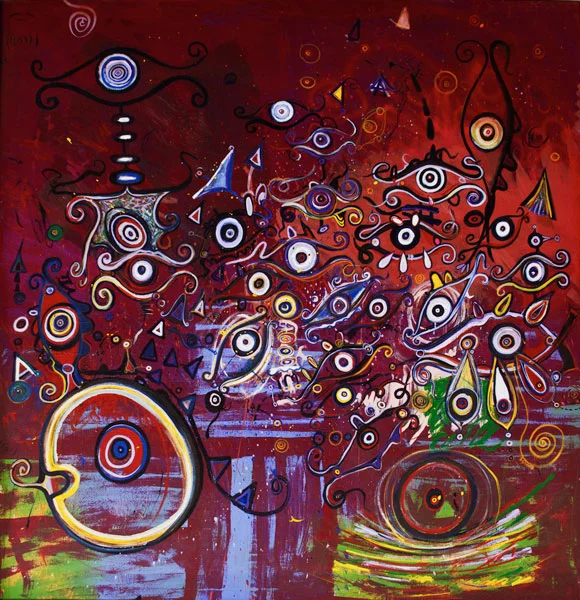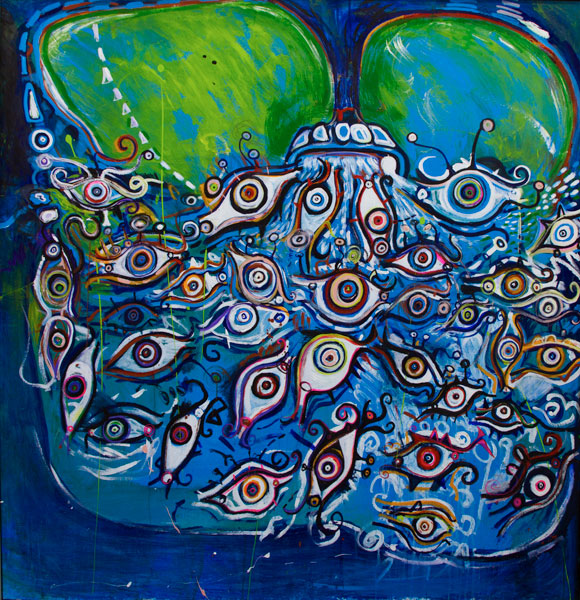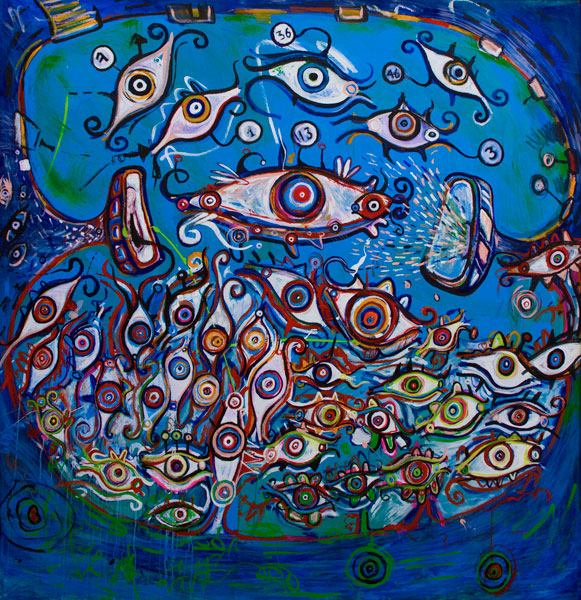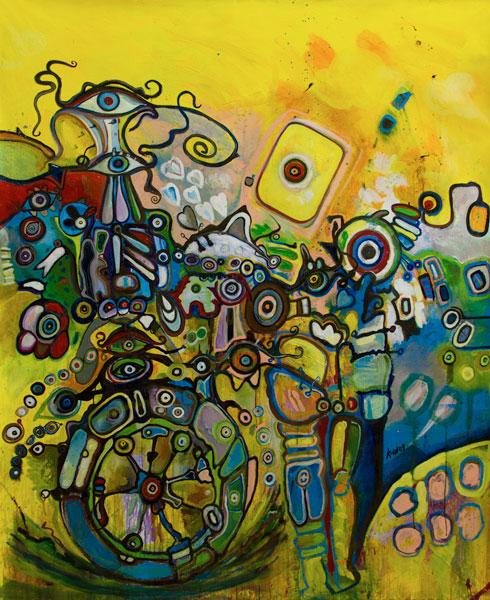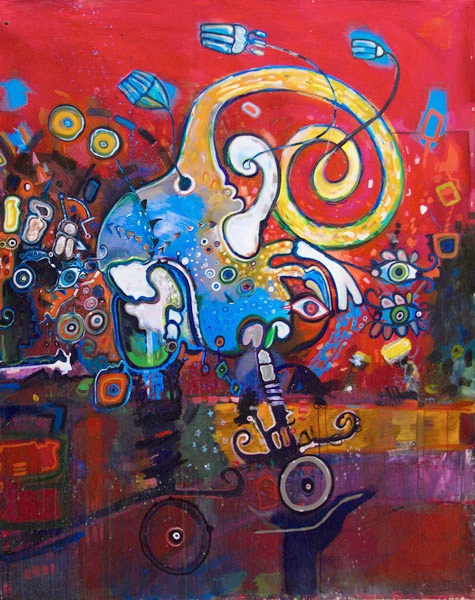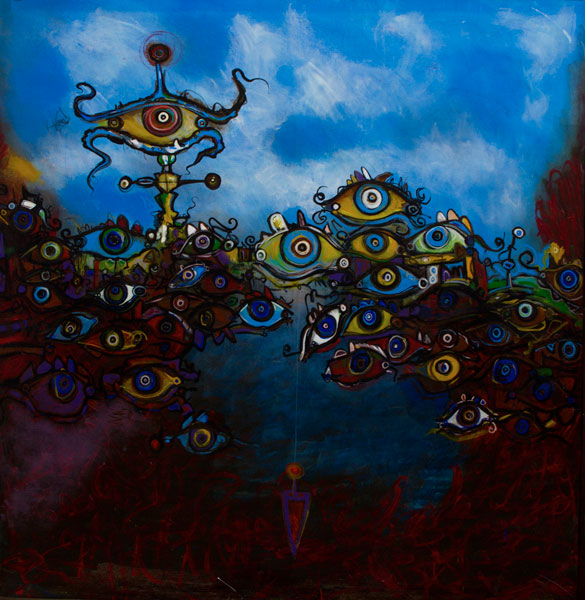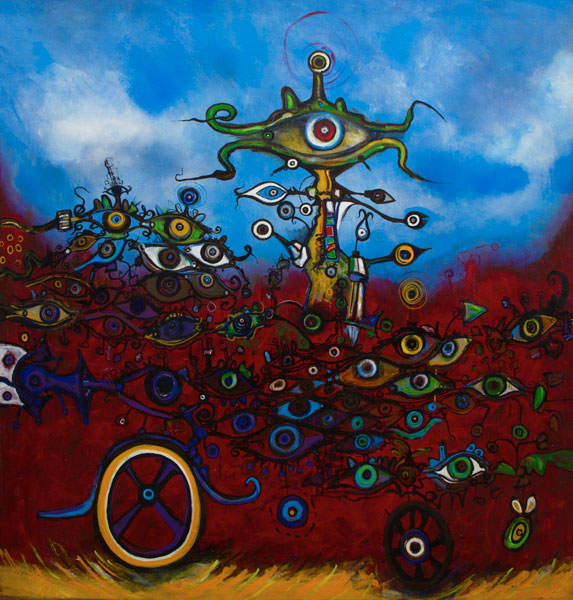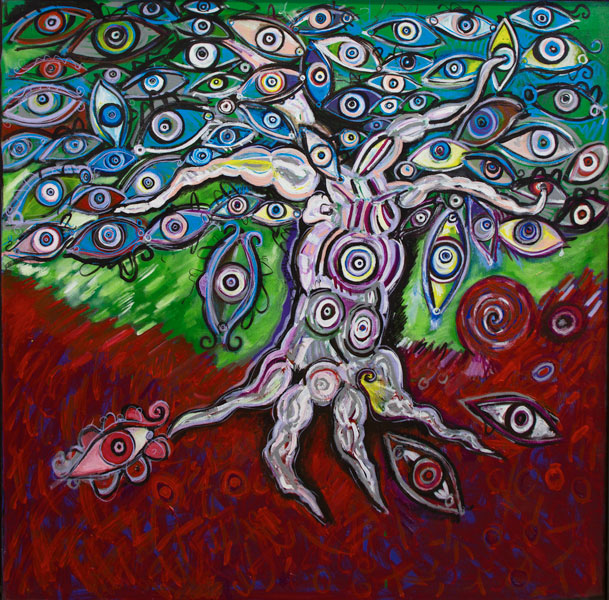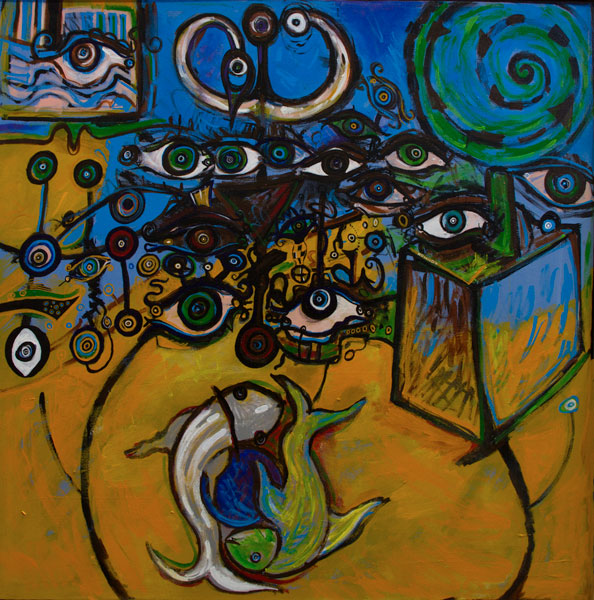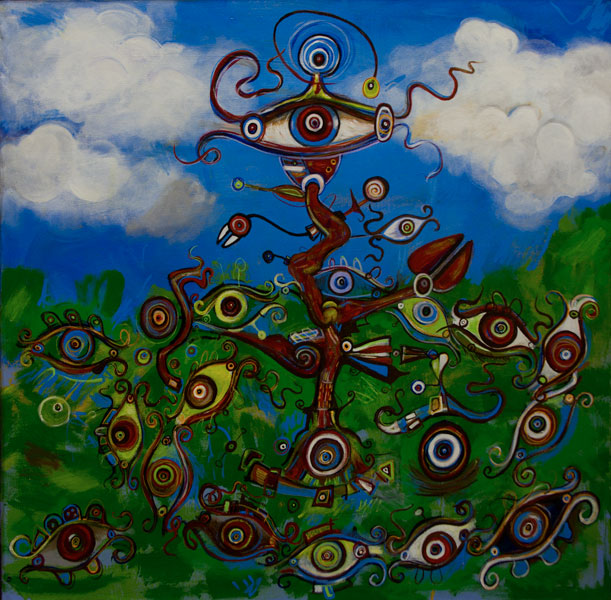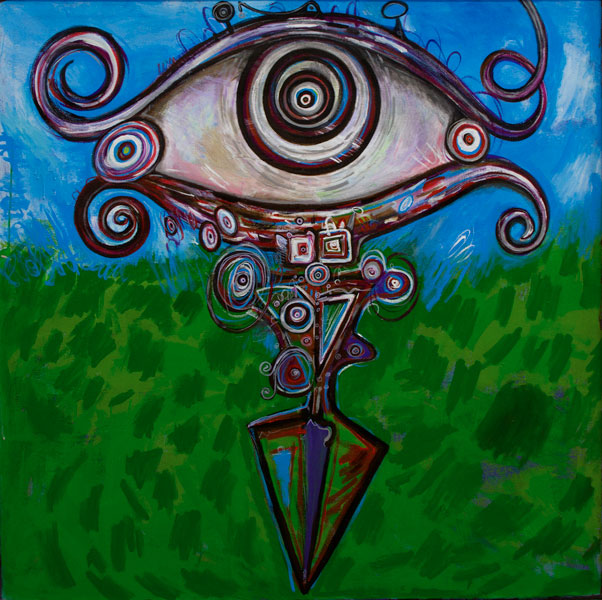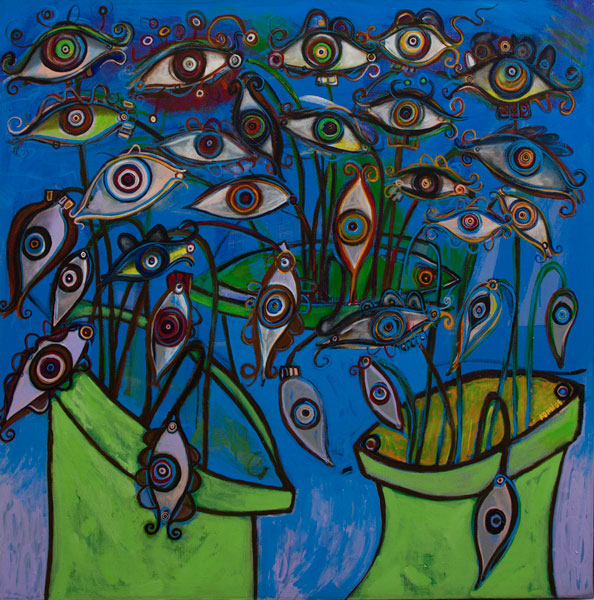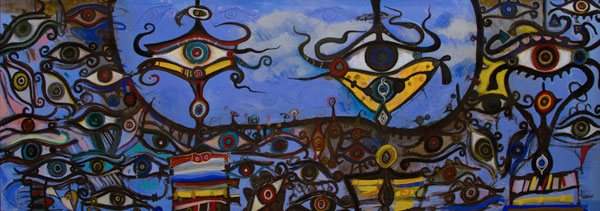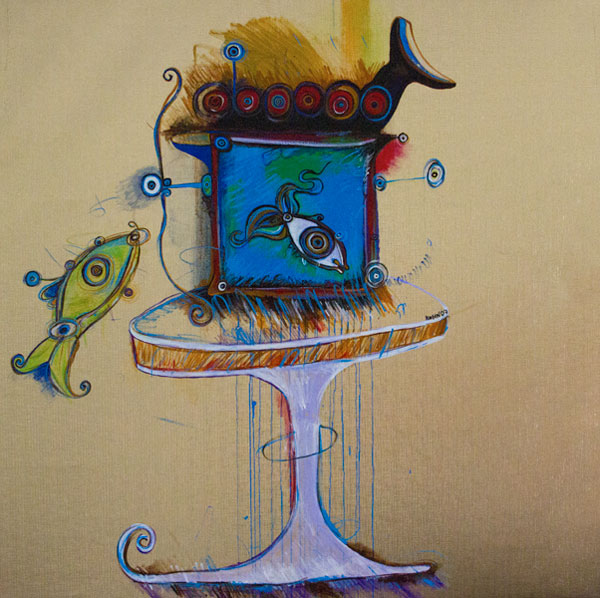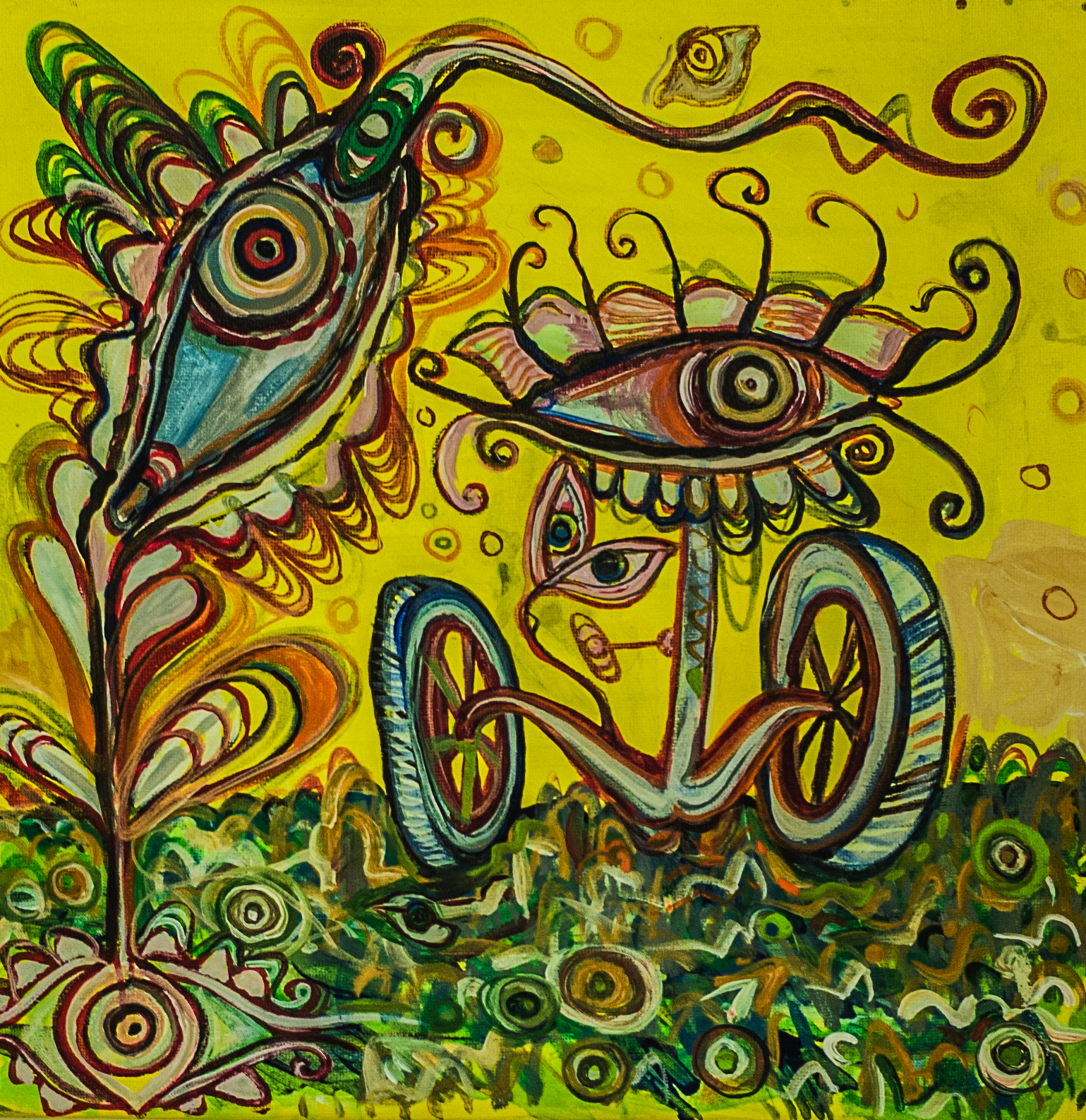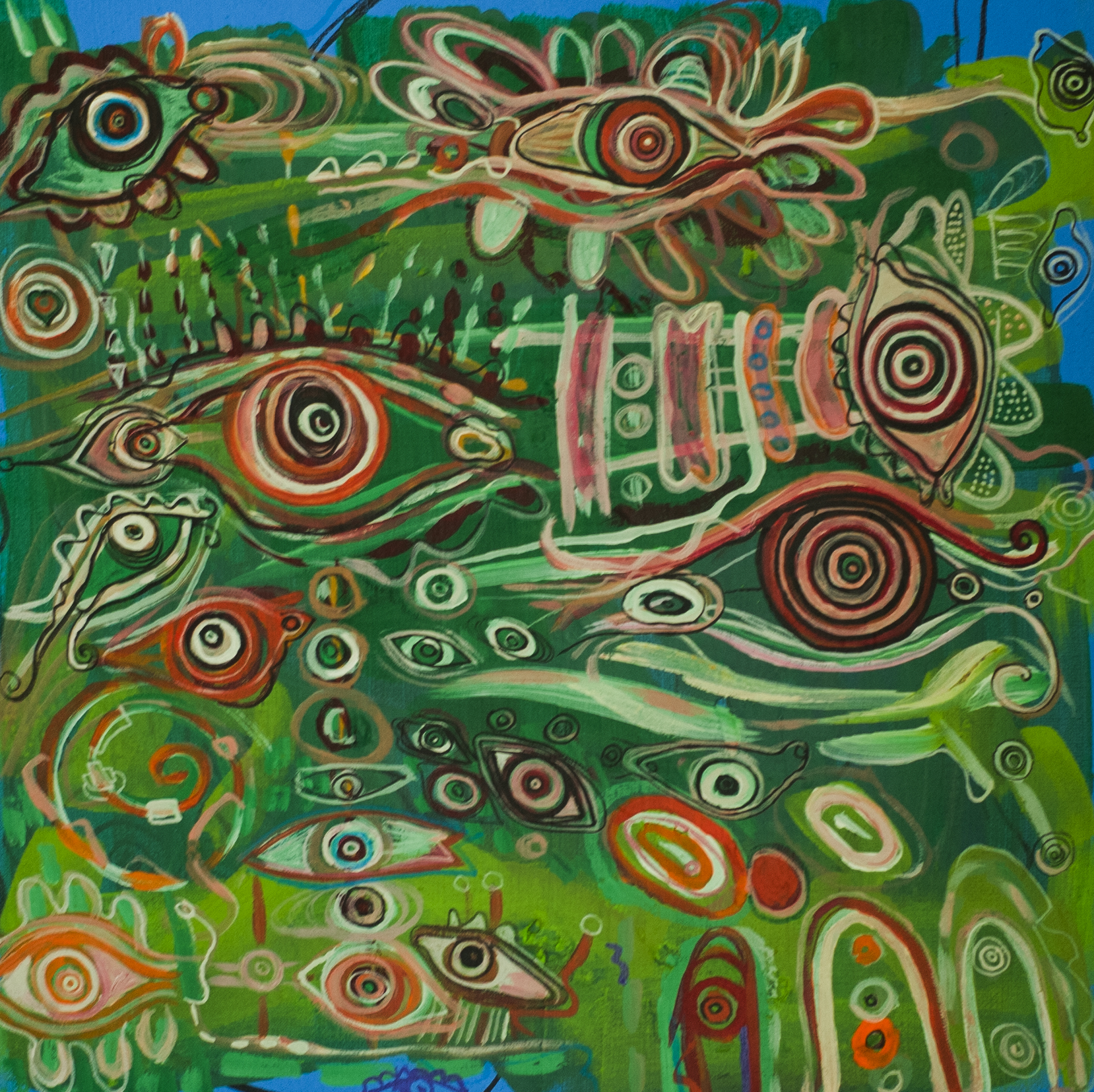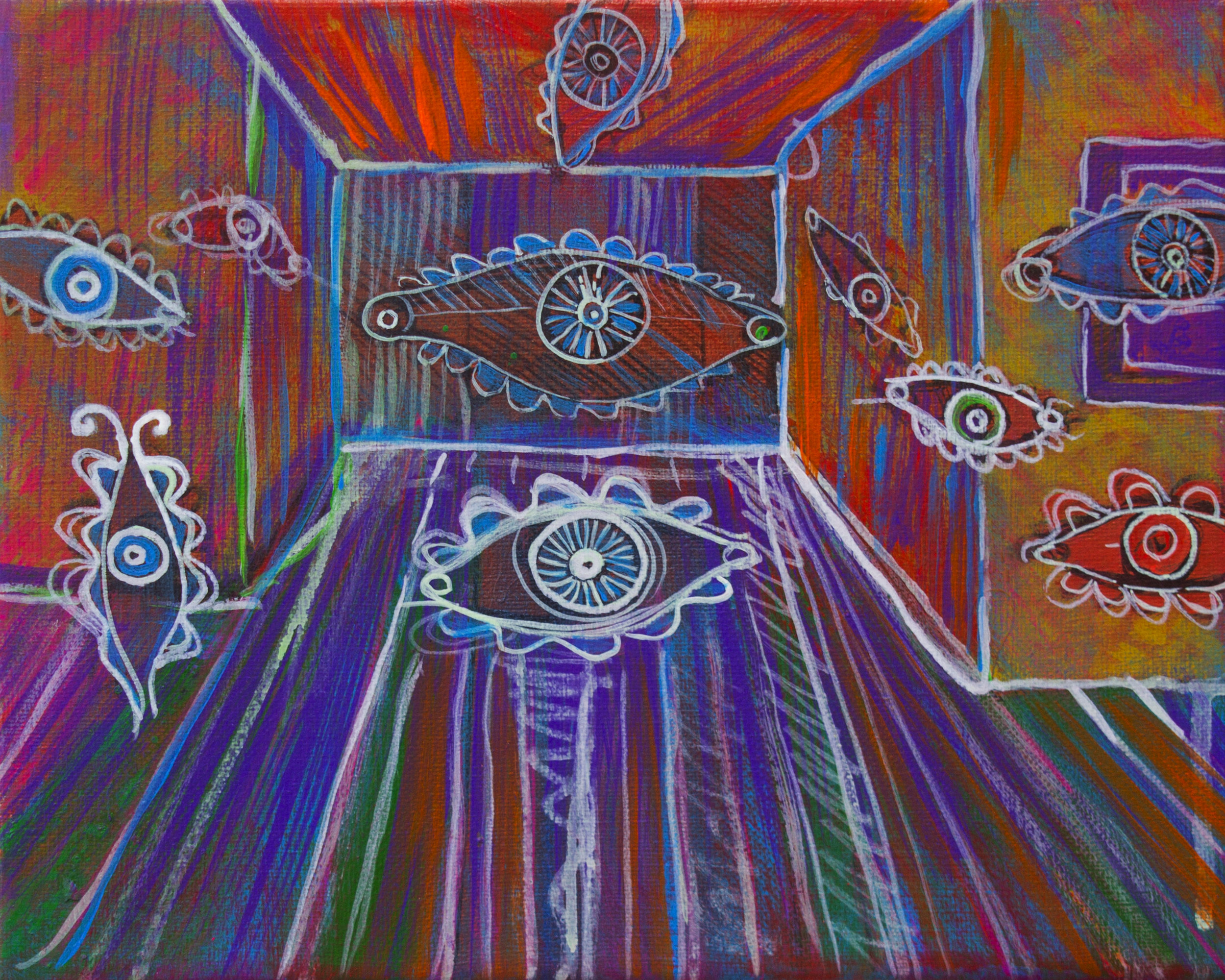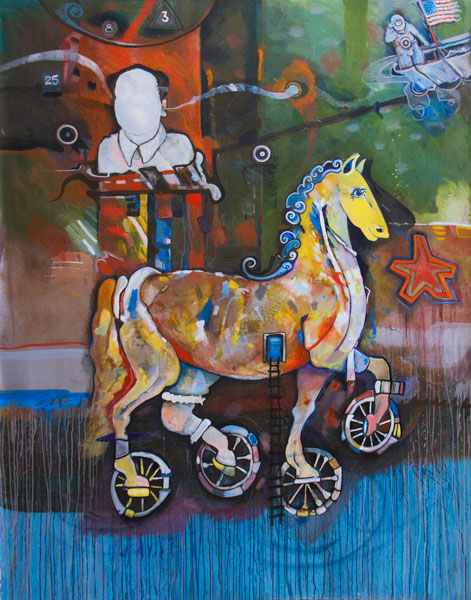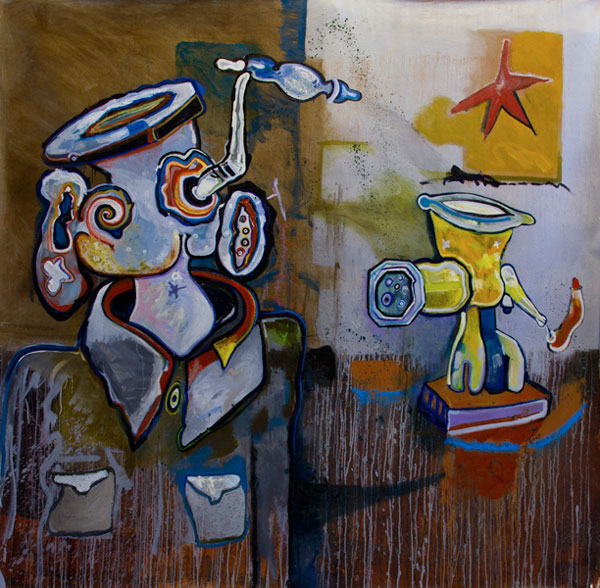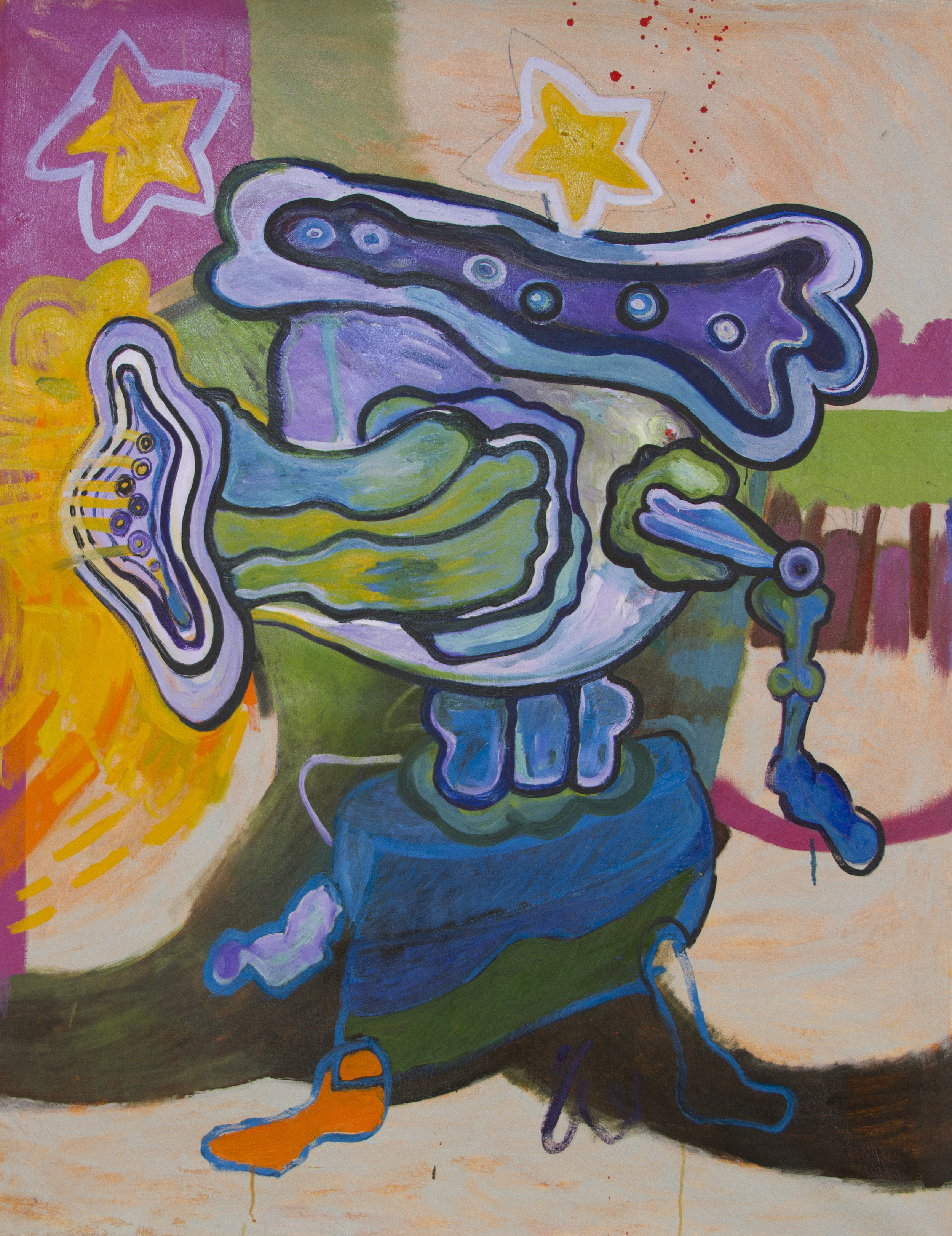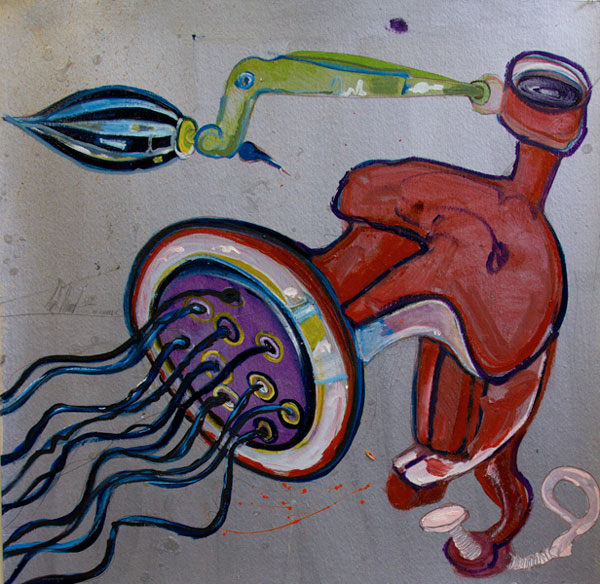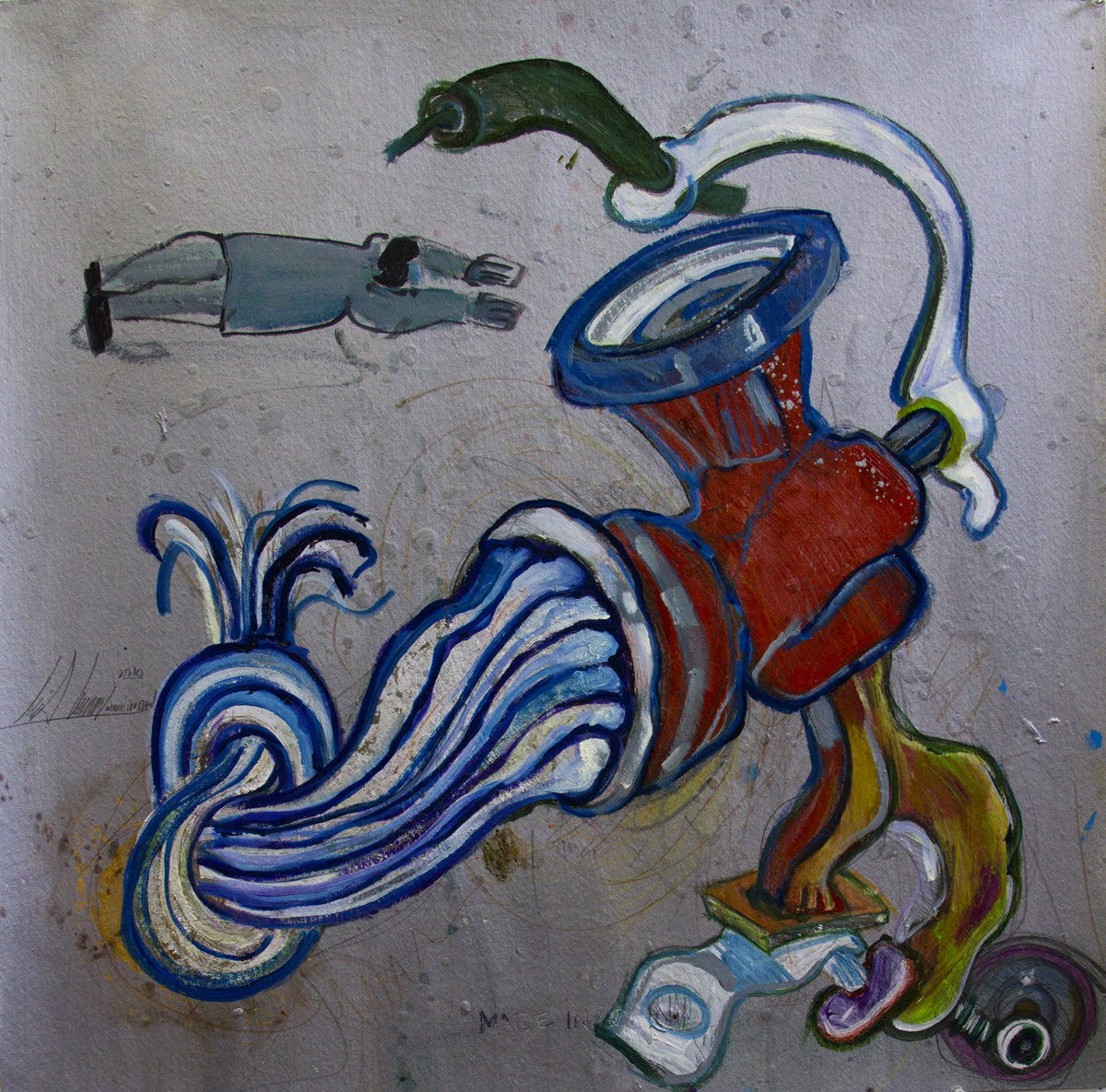RUDOLF KOHN ARTWORK
VICHARRO'S
I wonder if “Vicharros” as Rudolf Kohn calls this series, comes from the Spanish word “bichos” (critters), and when I stop in front of the composition I realize that it is the correct word, even though it is not in the Dictionary of the Real Academia de la Lengua Española and it represents, in a sarcastic way, the way a society becomes automatized. These are machines that come to life in the canvas: Human machines. If I come close I hear the musical notes and someone, from the wheeled coffee maker, is talking to me through the microphone. Machines are human and we, humans, have become machines.
One of the sharper aspects of this presentation is the bicycles. You can get a glimpse of a connection with your childhood memories. It is the innocence and complete freedom of a child that, in his maturity, cries out so we see ourselves in the mirror of the soulless robot we are turning into.
He joins opposite concepts in which the “Vicharros” are present to confirm the required balance between what we are and what we can be.
The soul searcher whispers in my ear: “…The wheels, the circles are a common element that repeats itself in the painting of this series. The circle is the center of the creation and the rays (radius of the circle) coming out of the center resemble the paths you can take in life. A concentric circle apart from the union of the two lenses indicates that in order to comprehend we have to adapt the whole view, is the third eye, the intuition. And two more circles are the lights of the awakening of the world, are the representation of creation.
The energy of the intense colors, alive, sparks a mental game and makes the spectator interested in the search for similarities between the images and his everyday life.
These are large-scale works, of mixed technique, where we can see the freedom of the brushstrokes on the canvas.
It is an exhibition in which we are transported to a world of awareness where we lock up the adult and become children again.
OZOTRON2027 ©
The Ozotron is an artistic proposal based on the idea of a futuristic society
where Man’s work, his very rhythm of life and the development of a society has
changed the life of the planet. Decades of constant pollution and waste has lead
mankind down this road. It has resulted in the greatest loss of life and natural
resources in the history of our planet. We stand at the absolute brink of
destruction. The end of human life and the absolute anhilation of the planet.
Mankind’s constant pollution finally caused for a large hole to open up in our
ozone layer unleashing the full fury of the Sun. The very fabric of our being is
contaminated. This contamination has forced those who survived to adapt to an
ever shrinking world with no clear hope in sight. In the face of this destruction
man is forced to adapt and more so evolve. Mankind finds itself with no pure air.
The contaminated world forces those alive to adapt by using an advanced
apparatus able to convert and create breathable air. The Ozotron is forced to
live in sealed spaces aptly called a Bunker. They use large scheme air
purificator’s while inside these bunker’s to create breathable air. The Ozotron
with the help of proper sealed masks were also able to create a portable form of
this purificator so advanced that it can be chewed like the present day chewing
gum.
Evolution being such a constant force, the Ozotron follows the Homo-sapien on
our evolution chart. A being absolutely conscious of the damaged caused by their
ancestors before them and more so the very reason of their forced existance.
He or She lives for the basic function of survival by gathering the basic elements
of life, something taken for granted by present day Man.
In this forced world the only memories of the nature are those stored and
registered by the ancestors of the Ozotron. They have stored treasures, sounds
of animals, and images of the phenomenon’s in nature such as wind, rain, rays
of sunlight, rivers and the sea. Some venture as far as growing a plant in their
small spaces in their bunker with a great deal of difficulty. Their pets now are
those very hated cockroaches of our present day. It serves them as a memory of
that which survived and reminds them of where they came from. The hated
insect now becomes a needed friend.
The technology of the Ozotron is based on purifying everything in order to to
survive. Its science is based on studying closely the behaviour of those that
came before them. Their goal is to recover what was lost by returning to the
simple and natural life that westill see in present day times in remote areas. The
Ozotron lives of their technological advancment. They conquer the quest and
science of time travel. They travel to the past in a different form with a warning
of times to come. They travel with the hope that Mankind will correct their
destructive ways. We see early forms of that type on conciousness in our
present day artists and politicians fighting for our green Earth. The Ozotron
fights so that the world corrects that and them as species, don't have to Exist.
CITY OF LOVE
Among all those eyes looking, I am looking for the eyes of the artist. I hope to see in them, somewhat almond-shaped, what I see in his work.
“…images that look like symbols and that could represent sacred aspects of a religion. They could also be a group of fusiform cells inmersed in a liquid womb…an eye, from the center, guards the water. It knows the lack of water threatens life in the Planet, it is the eye of God…” says the soul searcher to Rudolph Kohn, who answers: “The eyes represent the presence of an absence.”
I think about what I can’t grasp, that what I can’t explain but I know and feel inside. Rudolf Kohn takes me out of my self absortion, he continues: even if we are alone there is a presence, a presence of something, someone in us, inside us. I multiply these feeling intertwined with the affirmation of being, I develop these cities where all you can see is the gathering of people, of thoughts, living as one in an ideal society.
How to represent feelings, ideas, and thoughts…in a canvas?
What is the process?
For how long should you ponder on an idea before you start developing it? Or do you simply act...?It is true that we are all the same, in the end we are humans. What makes a difference in our way to create are our experiences. The essence is the creative act, therefore individual, although sometimes we react collectively to an event.
The question we have asked ourselves sometime is: what is the reason for being, why be? Where is the energy moving to? Is our planet the only one with human life as we know it?
In the series titled “City of Love” we see the connection, the similarities, and also the differences and dissimilar forms: none similar to the other, like a fingerprint. It is life, beginning and end, to be born and create again. Time doesn’t stop, and we don’t know if we will ever reach the turning point in which time stops. Maybe it is in the canvas where we will find eternity or speedtime…”
The eyes are Rudolf Kohn’s symbolic language. Since he was very young he has seen in them a representation of the unity of human beings, because you can sense in them the feelings and physical, mental and material aspects of the human beings of our planet.
I stop looking into his eyes to inmerse myself in the womb of City of Love and I swim in the liquid of life, in the living water of its creation
MADE IN CHINA
This series of work is a symbolic representation of the current economic crisis between China and the United States. China is the largest foreign holder of the United States, owning eight percent of the States’ national loan debt – and due to growing economic interdependence, American culture remains indebted to the interests of the Chinese government. In the first painting of the series entitled “Caballo de Troya” (The Trojan Horse), Kohn demonstrates the “gifting” of a Trojan horse to the United States from China. The horse was a tool utilized by Ancient Greece to trick the enemy into thinking they were victorious, when in fact there were soldiers hiding inside of the horse, waiting patiently to destroy and conquer their opponent. The faceless man on the upper left is a representation of Mao Zedong, the first leader of communist China, and the astronaut on the upper right is a representation of the United States. Years have passed since the economic relationship between the two countries began, and the United States has realized the magnitude of control China has over world affairs. The second painting of the series, entitled “Tranpoline Mao Zedong,” displays Mao Zedong jumping into a meat-grinder and creating an output of products, represented by stars. In the third painting, “Transformation of Mao Zedong Into a Meat Grinder,” we see Mao’s face actually become the meat grinder, embodying the machine itself. All paintings in the series are varied interpretations of this imagery: the United States has been tricked, and there is no way back.
.



